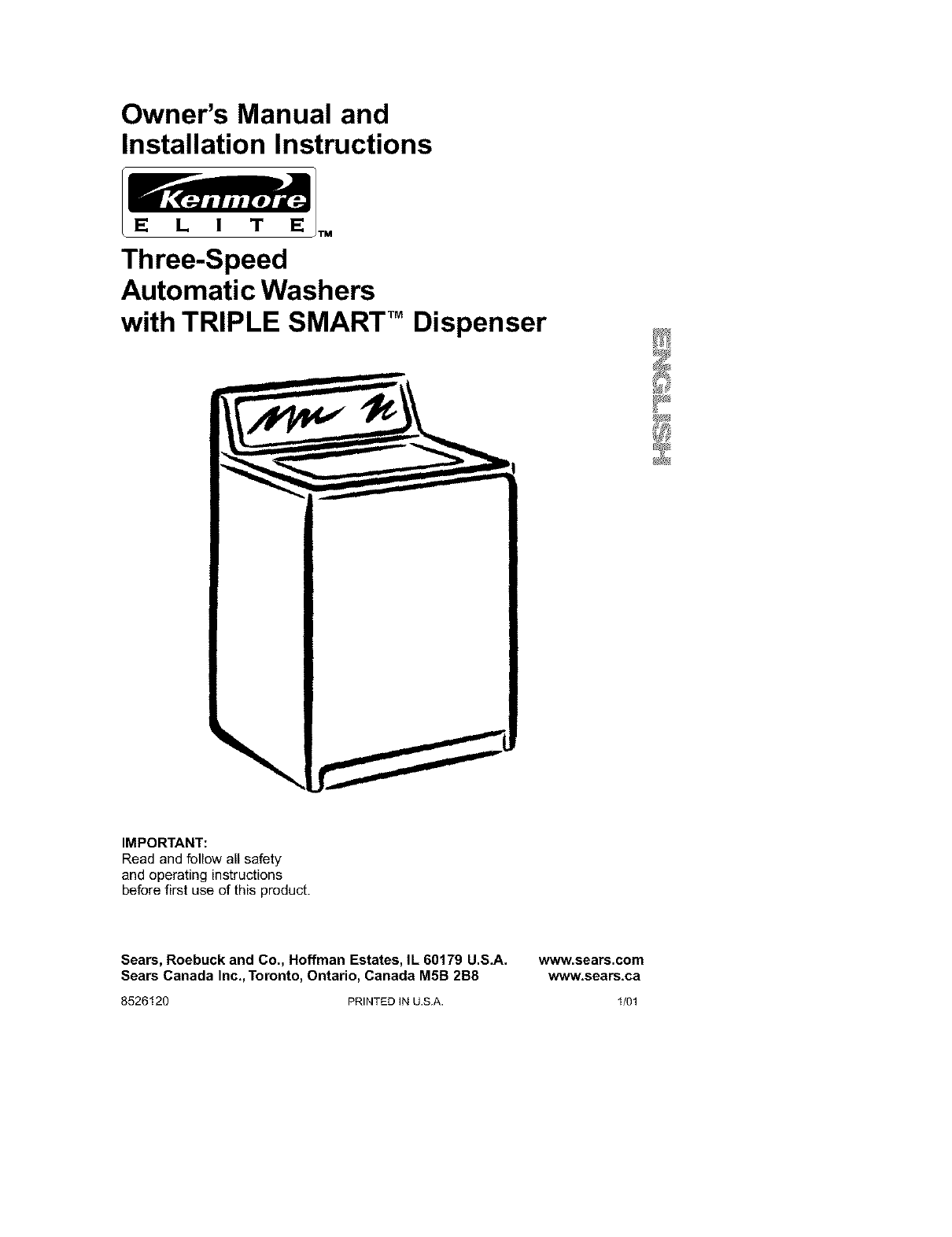
Owner's Manual and
Installation Instructions
E L I T E
TM
Three-Speed
Automatic Washers
with TRIPLE SMART TM Dispenser
IMPORTANT:
Read and follow all safety
and operating instructions
before first use of this product.
www, sears.com
www, sears,ca
Sears, Roebuck and Co., Hoffman Estates, IL 60179 U.S.A.
Sears Canada Inc., Toronto, Ontario, Canada M5B 2B8
8526120 PRINTED IN U.S.A. 1/01
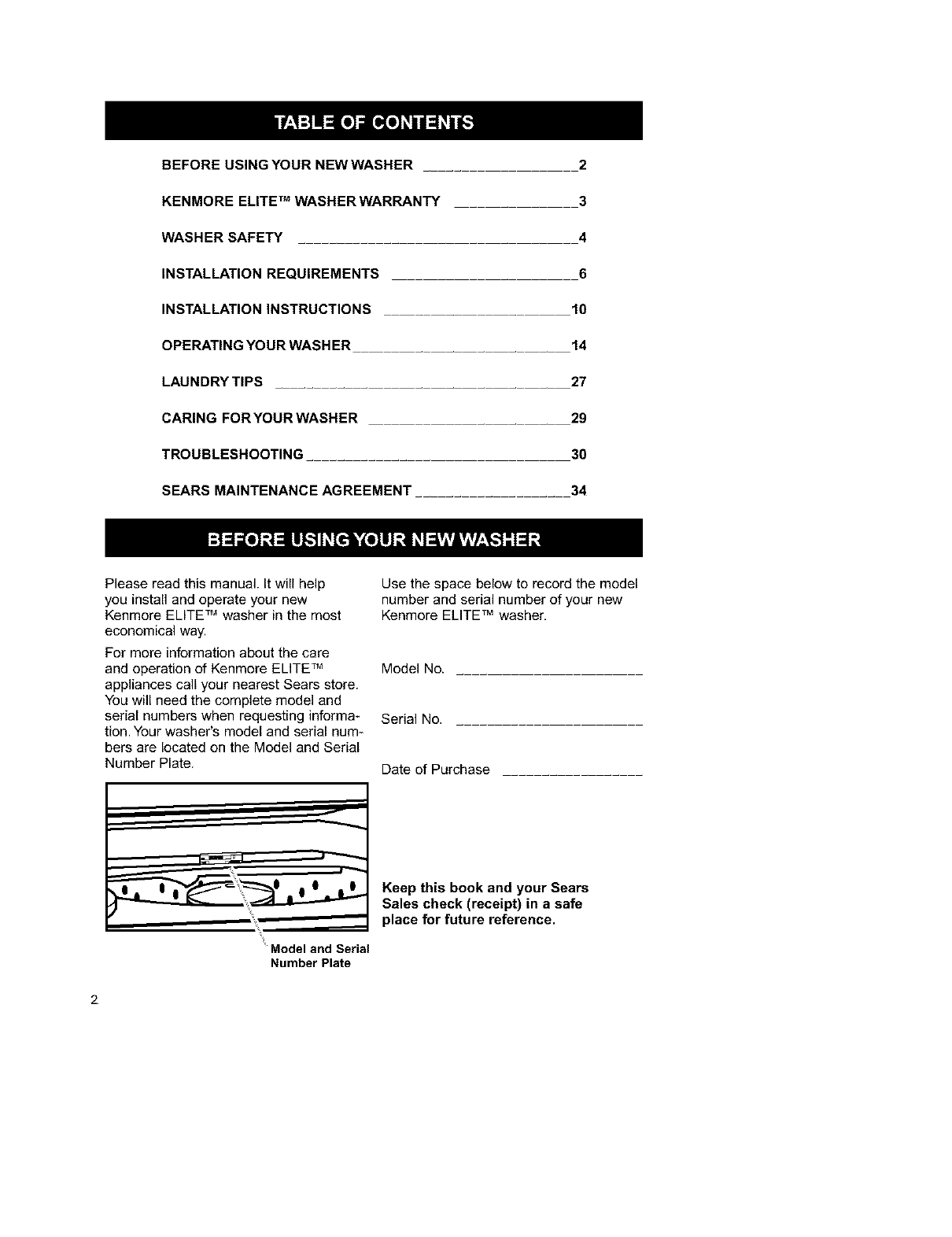
BEFORE USING YOUR NEWWASHER _ __ 2
KENMORE ELITE TM WASHER WARRANTY 3
WASHER SAFETY ............ 4
INSTALLATION REQUIREMENTS
INSTALLATION INSTRUCTIONS
OPERATING YOUR WASH ER
6
10
14
LAUNDRY TIPS ........... 27
CARING FOR YOUR WASHER 29
TROUBLESHOOTING ........ 30
SEARS MAINTENANCE AGREEMENT 34
Please read this manual. It will help
you install and operate your new
Kenmore ELITE TM washer in the most
economical way.
For more information about the care
and operation of Kenmore ELITE TM
appliances call your nearest Sears store.
You will need the complete model and
serial numbers when requesting informa-
tion. Your washer's model and serial num*
bers are located on the Model and Serial
Number Plate.
Use the space below to record the model
number and serial number of your new
Kenmore ELITE TM washer,
Model No.
Serial No.
Date of Purchase
Modeland Serial
Number Plate
Keep this book and your Sears
Sales check (receipt) in a safe
place for future reference.
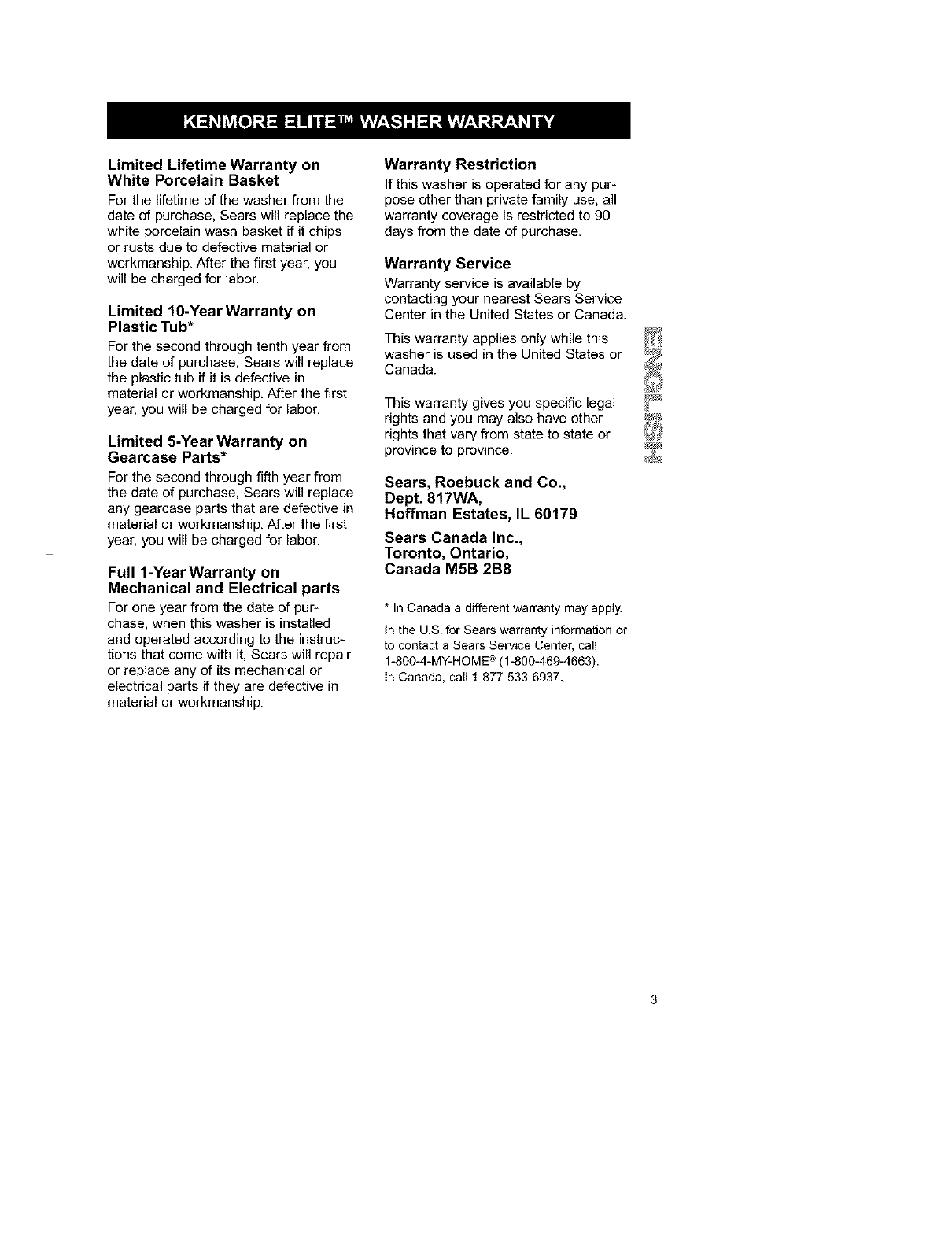
Limited Lifetime Warranty on
White Porcelain Basket
For the lifetime of the washer from the
date of purchase, Sears will replace the
white porcelain wash basket if it chips
or rusts due to defective material or
workmanship. After the first year, you
will be charged for labor.
Limited 10-Year Warranty on
Plastic Tub*
For the second through tenth year from
the date of purchase, Sears will replace
the plastic tub if it is defective in
material or workmanship, After the first
year, you will be charged for labor.
Limited 5-Year Warranty on
Gearcase Parts*
For the second through fifth year from
the date of purchase, Sears will replace
any gearcase parts that are defective in
material or workmanship, After the first
year, you will be charged for labor.
Full 1-Year Warranty on
Mechanical and Electrical parts
For one year from the date of pur-
chase, when this washer is installed
and operated according to the instruc-
tions that come with it, Sears will repair
or replace any of its mechanical or
electrical parts if they are defective in
material or workmanship.
Warranty Restriction
If this washer is operated for any pur-
pose other than private family use, all
warranty coverage is restricted to 90
days from the date of purchase.
Warranty Service
Warranty service is available by
contacting your nearest Sears Service
Center in the United States or Canada.
This warranty applies only while this
washer is used in the United States or
Canada.
This warranty gives you specific legal
rights and you may also have other
rights that vary from state to state or
province to province.
Sears, Roebuck and Co.,
Dept. 817WA,
Hoffman Estates, IL 60179
Sears Canada Inc.,
Toronto, Ontario,
Canada M5B 2B8
* In Canada a different warranty may apply.
In the U.S. for Sears warranty information or
to contact a Sears Service Center, call
1-80O-4-MY-HQME ® (1-890-469-4663).
in Canada, call 1-877-533-6937.
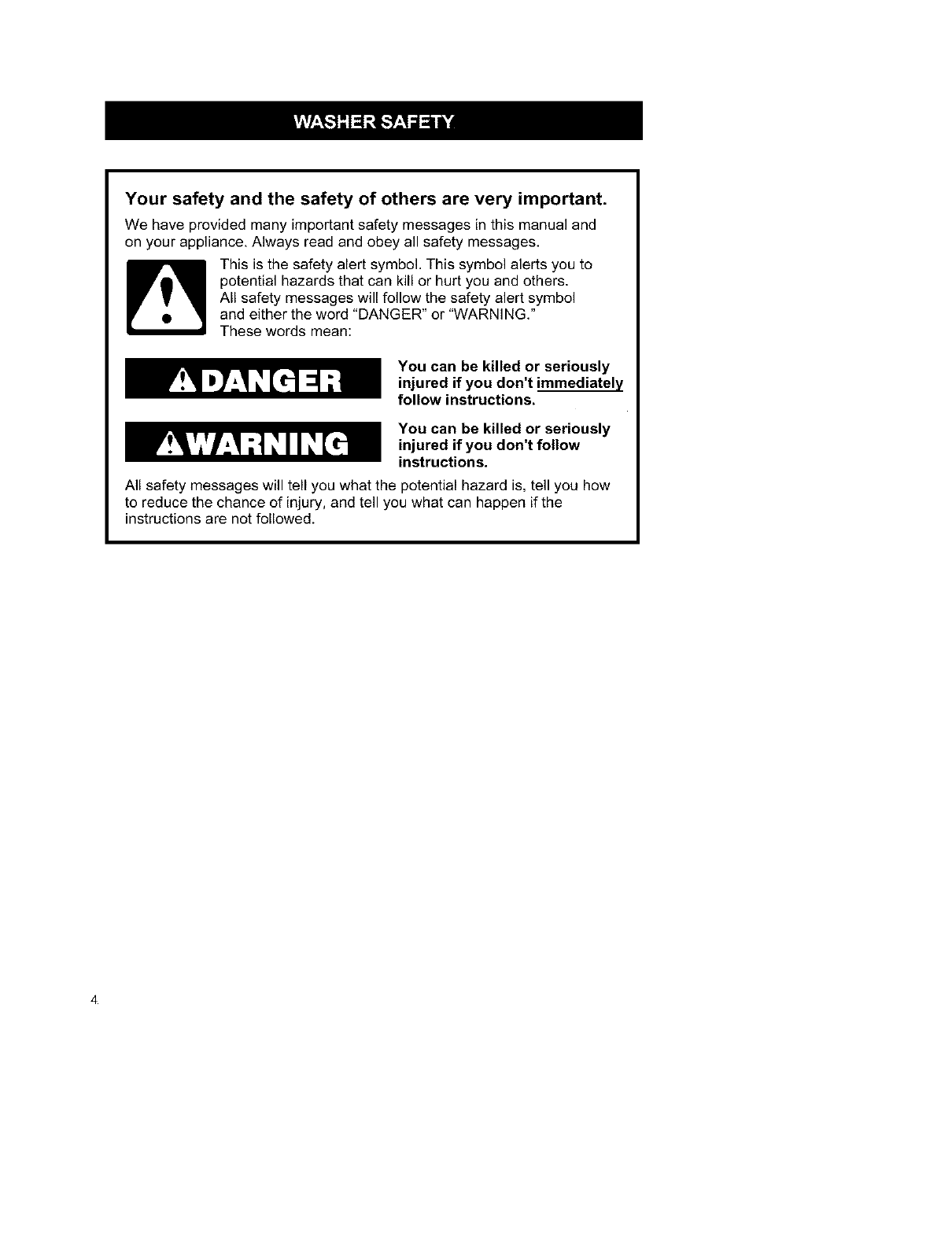
Your safety and the safety of others are very important.
We have provided many important safety messages in this manual and
on your appliance. Always read and obey all safety messages.
This is the safety alert symbol. This symbol alerts you to
potential hazards that can kill or hurt you and others.
All safety messages will follow the safety alert symbol
and either the word "DANGER" or "WARNING."
These words mean:
You can be killed or seriously
injured if you don't immediateb L
follow instructions.
You can be killed or seriously
injured if you don't follow
instructions.
All safety messages will tell you what the potential hazard is, tell you how
to reduce the chance of injury, and tell you what can happen if the
instructions are not followed.
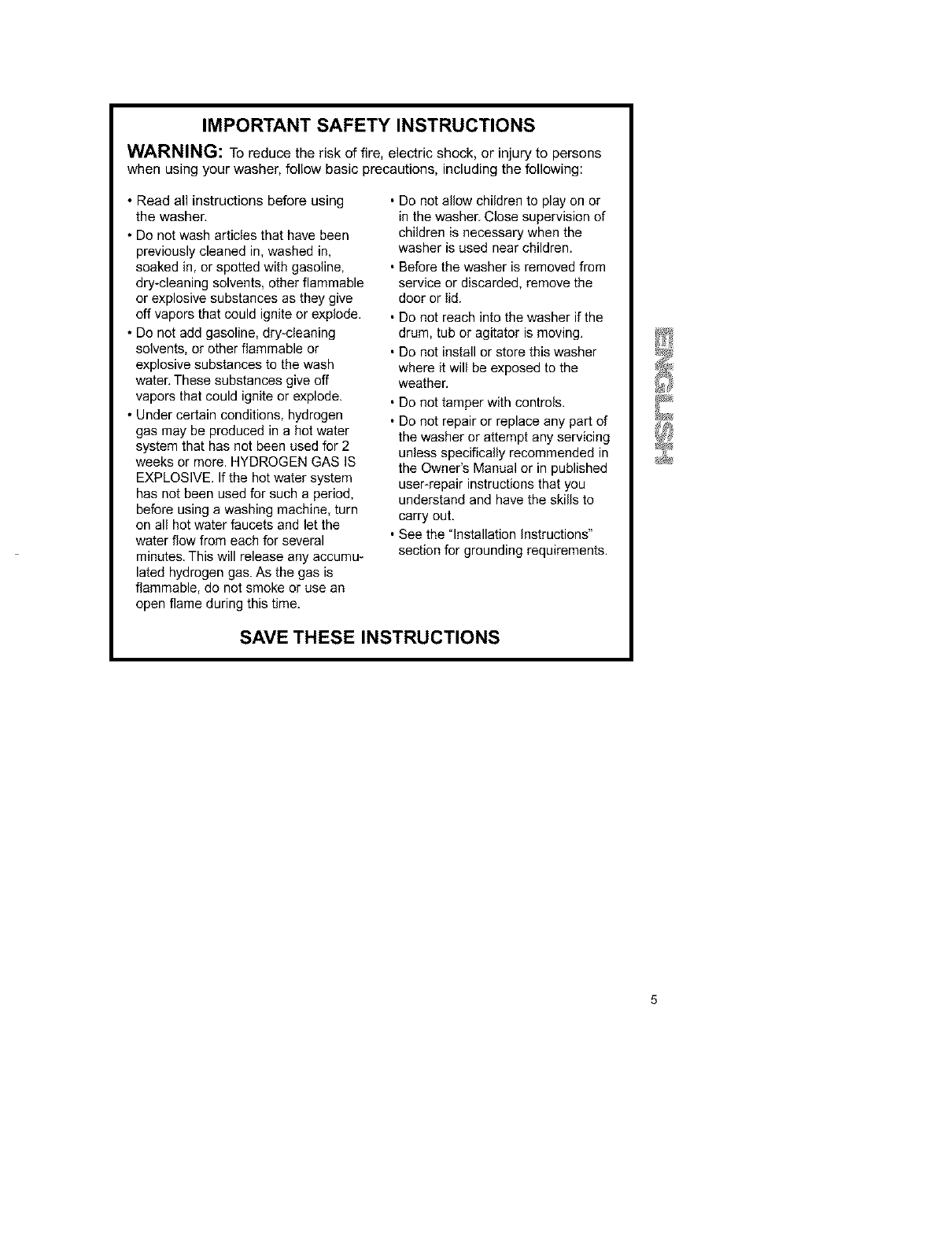
IMPORTANT SAFETY INSTRUCTIONS
WARNING: To reduce the risk of fire, electric shock, or injury to persons
when using your washer, follow basic precautions, including the following:
• Read all instructions before using
the washer.
• Do not wash articles that have been
previously cleaned in, washed in,
soaked in, or spotted with gasoline,
dry-cleaning solvents, other flammable
or explosive substances as they give
off vapors that could ignite or explode,
• Do not add gasoline, dry-cleaning
solvents, or other flammable or
explosive substances to the wash
water. These substances give off
vapors that could ignite or explode.
• Under certain conditions, hydrogen
gas may be produced in a hot water
system that has not been used for 2
weeks or more. HYDROGEN GAS IS
EXPLOSIVE. If the hot water system
has not been used for such a period,
before using a washing machine, turn
on all hot water faucets and let the
water flow from each for several
minutes. This will release any accumu-
lated hydrogen gas. As the gas is
flammable, do not smoke or use an
open flame during this time.
• Do not allow children to play on or
in the washer. Close supervision of
children is necessary when the
washer is used near children.
• Before the washer is removed from
service or discarded, remove the
door or Iid.
• Do not reach into the washer if the
drum, tub or agitator is moving.
• Do not install or store this washer
where it will be exposed to the
weather,
• Do not tamper with controls.
• Do not repair or replace any part of
the washer or attempt any servicing
unless specifically recommended in
the Owner's Manual or in published
user-repair instructions that you
understand and have the skills to
carry out.
• See the "Installation instructions"
section for grounding requirements.
SAVE THESE INSTRUCTIONS
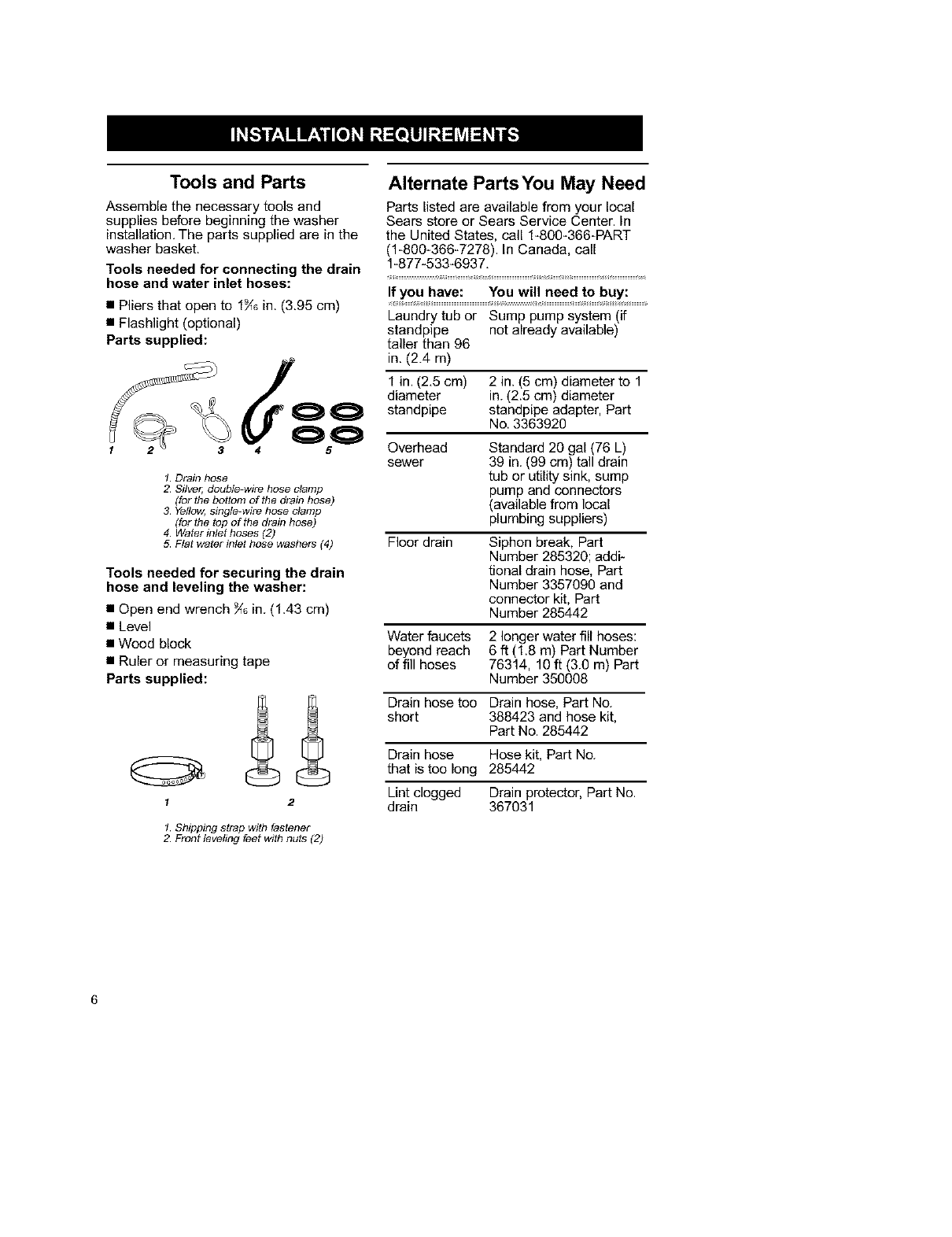
Tools and Parts
Assemble the necessary tools and
supplies before beginning the washer
installation. The parts supplied are in the
washer basket.
Tools needed for connecting the drain
hose and water inlet hoses:
• Pliers that open to 1?'6 in. (3.95 cm)
• Flashlight (optional)
Parts supplied:
4 5
1. Drain hose
2. Silver, double-wire hose clamp
(for the bottom of the drain hose)
3. Yellow, single-wire hose clamp
(for the top of the drain hose)
4. Water inlet hoses (2)
5. Flat water inlet hose washers (4)
Tools needed for securing the drain
hose and leveling the washer:
• Open end wrench ?'6 in. (1.43 cm)
• Level
• Wood block
• Ruler or measuring tape
Parts supplied:
1 2
1. Shipping strap with fastener
Z Front leveling feet with nuts (2)
Alternate PartsYou May Need
Parts listed are available from your local
Sears store or Sears Service Center. In
the United States, call 1-800-366-PART
(1-800-366-7278). In Canada, call
1-877-533_6937.
If you have: You will need to buy:
Laundry tub or Sump pump system (if
standpipe not already available)
taller than 96
in. (2.4 m)
1 in. (2.5 cm) 2 in. (5 cm) diameter to 1
diameter in. (2.5 cm) diameter
standpipe standpipe adapter, Part
No. 3363920
Overhead Standard 20 gal (76 L)
sewer 39 in. (99 cm) tall drain
tub or utility sink, sump
pump and connectors
(available from local
plumbing suppliers)
Floor drain Siphon break, Part
Number 285320; addi*
tional drain hose, Part
Number 3357090 and
connector kit, Part
Number 285442
Water faucets 2 longer water fill hoses:
beyond reach 6 ft (1.8 m) Part Number
of fill hoses 76314, 10 ft (3.0 m) Part
Number 350008
Drain hose too Drain hose, Part No.
short 388423 and hose kit,
Part No. 285442
Drain hose Hose kit, Part No.
that is too long 285442
Lint clogged Drain protector, Part No.
drain 367031
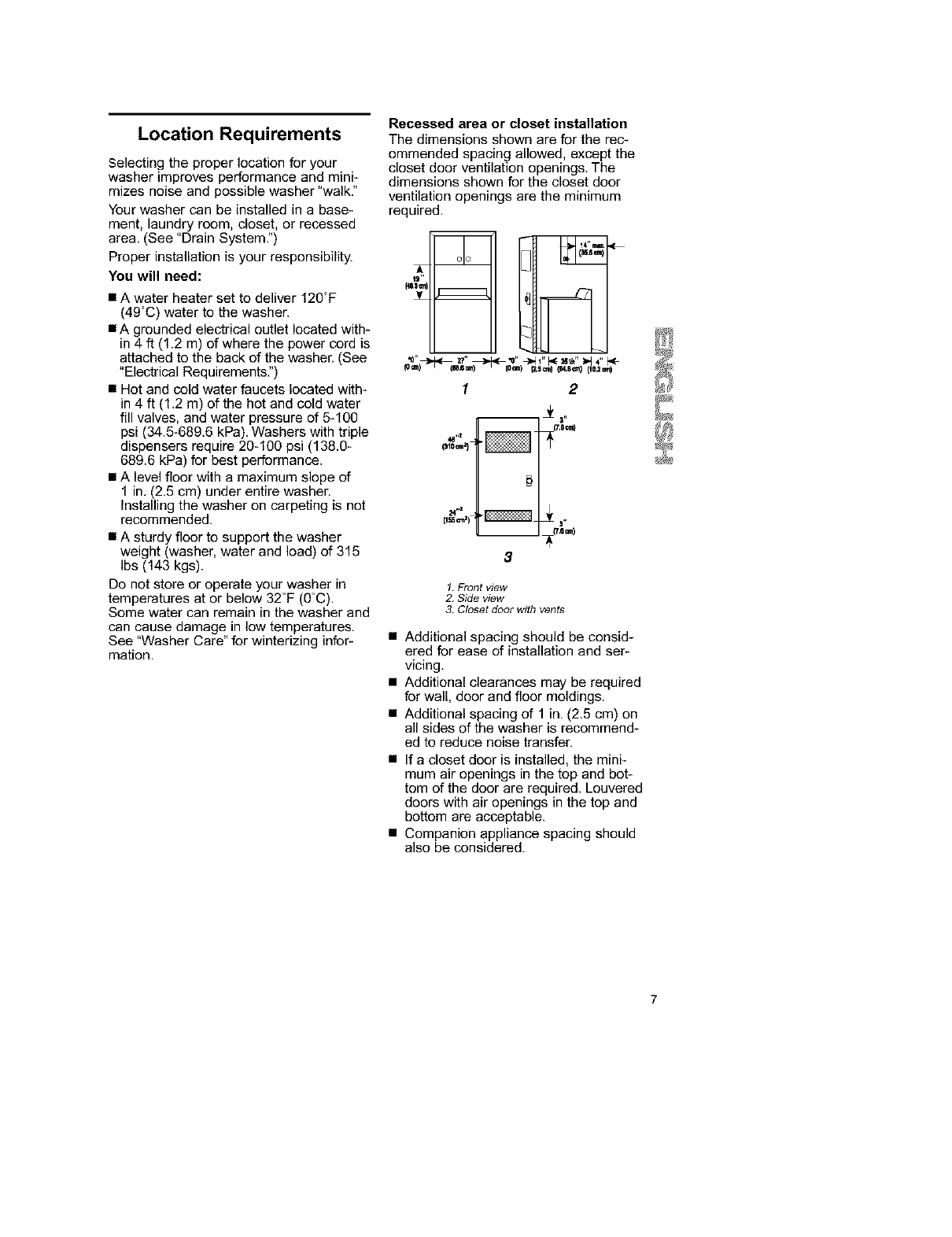
Location Requirements
Selecting the proper location for your
washer improves performance and mini-
mizes noise and possible washer "walk,"
Your washer can be installed in a base-
ment, laundry room, closet, or recessed
area. (See "Drain System.")
Proper installation is your responsibility.
You will need:
• A water heater set to deliver 120T
(49_C) water to the washer.
• A grounded electrical outlet located with-
in 4 ft (1.2 m) of where the power cord is
attached to the back of the washer. (See
"Electrical Requirements.")
• Hot and cold water faucets located with-
in 4 ft (1.2 m) of the hot and cold water
fill valves, and water pressure of 5-100
psi (34.5-689.6 kPa). Washers with triple
dispensers require 20-100 psi (138.0-
689.6 kPa) for best performance.
• A level floor with a maximum slope of
1 in. (2.5 cm) under entire washer.
Installing the washer on carpeting is not
recommended.
• A sturdy floor to support the washer
weight (washer, water and load) of 315
Ibs (143 kgs).
Do not store or operate your washer in
temperatures at or below 32°F (0°C).
Some water can remain in the washer and
can cause damage in low temperatures.
See "Washer Care" for winterizing infor-
mation.
Recessed area or closet installation
The dimensions shown are for the rec-
ommended spacing allowed, except the
closet door ventilation openings, The
dimensions shown for the closet door
ventilation openings are the minimum
required.
m
1 2
-- _r 3.
24,,2
3
1. Front view
2. Side view
3. Closet door with vents
• Additional spacing should be consid-
ered for ease of installation and ser-
vicing.
• Additional clearances may be required
for wall, door and floor moldings.
• Additional spacing of 1 in. (2.5 cm) on
all sides of the washer is recommend-
ed to reduce noise transfer.
• If a closet door is installed, the mini-
mum air openings in the top and bot-
tom of the door are required. Louvered
doors with air openings in the top and
bottom are acceptable.
• Companion appliance spacing should
also be considered.
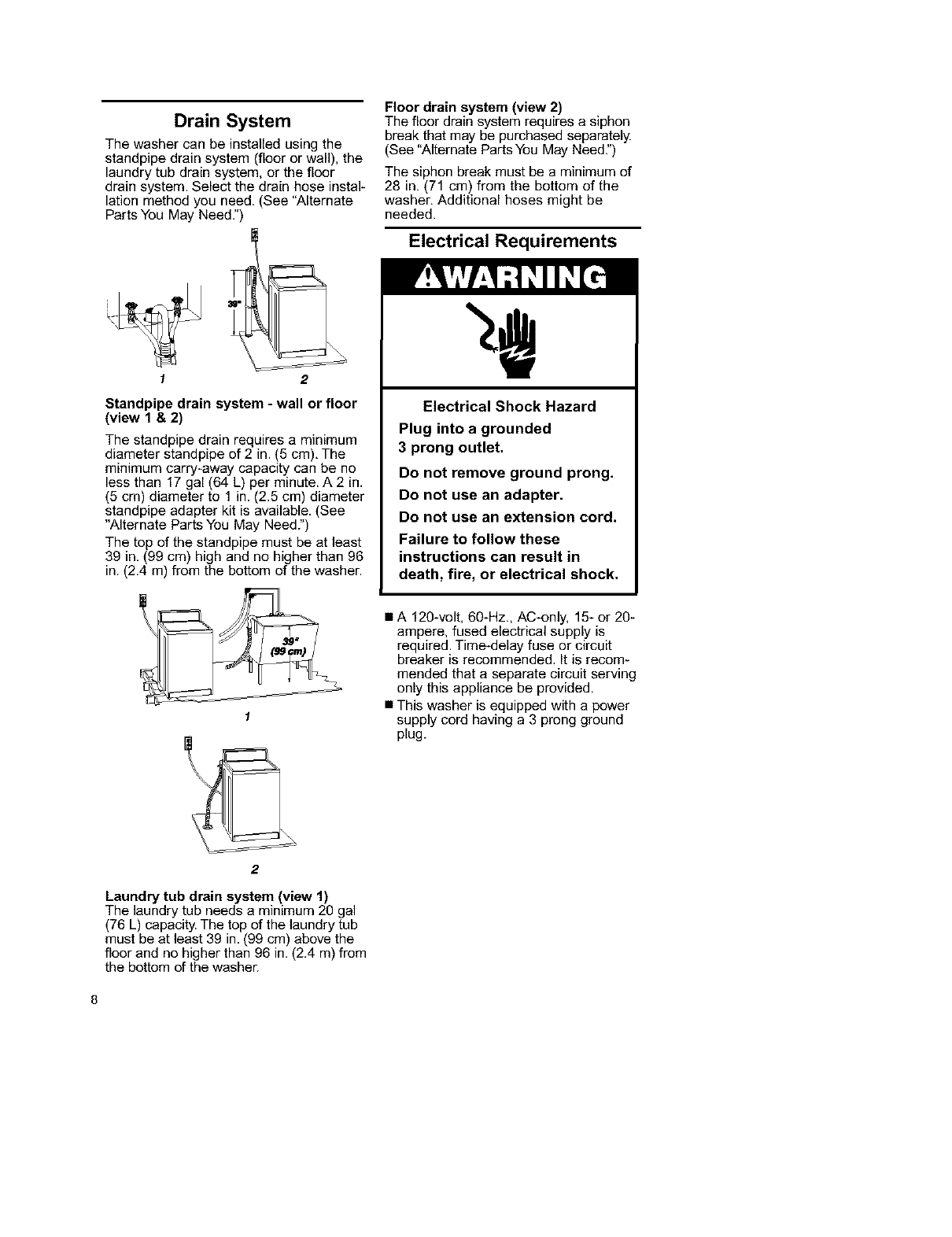
Drain System
The washer can be installed using the
standpipe drain system (floor or wall), the
laundry tub drain system, or the floor
drain system. Select the drain hose instal-
lation method you need. (See "Alternate
Parts You May Need.")
1 2
Standpipe drain system - wall or floor
(view 1 & 2)
The standpipe drain requires a minimum
diameter standpipe of 2 in. (5 cm). The
minimum carry-away capacity can be no
less than 17 gal (64 L) per minute. A 2 in.
(5 cm) diameter to 1 in. (2.5 cm) diameter
standpipe adapter kit is available. (See
"Alternate Parts You May Need.")
The top of the standpipe must be at least
39 in. (99 cm) high and no higher than 96
in. (2.4 m) from the bottom of the washer.
Floor drain system (view 2)
The floor drain system requires a siphon
break that may be purchased separately.
(See "Alternate PartsYeu May Need,")
The siphon break must be a minimum of
28 in. (71 cm) from the bottom of the
washer. Additional hoses might be
needed.
Electrical Requirements
Electrical Shock Hazard
Plug into a grounded
3 prong outlet.
Do not remove ground prong.
Do not use an adapter.
Do not use an extension cord.
Failure to follow these
instructions can result in
death, fire, or electrical shock.
• A 120-volt, 60-Hz., AC-only, 15- or 20-
ampere, fused electrical supply is
required. Time-delay fuse or circuit
breaker is recommended, It is recom-
mended that a separate circuit serving
only this appliance be provided,
• This washer is equipped with a power
supply cord having a 3 prong ground
plug.
Laundry tub drain system (view 1)
The laundry tub needs a minimum 20 gal
(76 L) capacity. The top of the laundry tub
must be at least 39 in. (99 cm) above the
floor and no higher than 96 in. (2.4 m) from
the bottom of the washer.
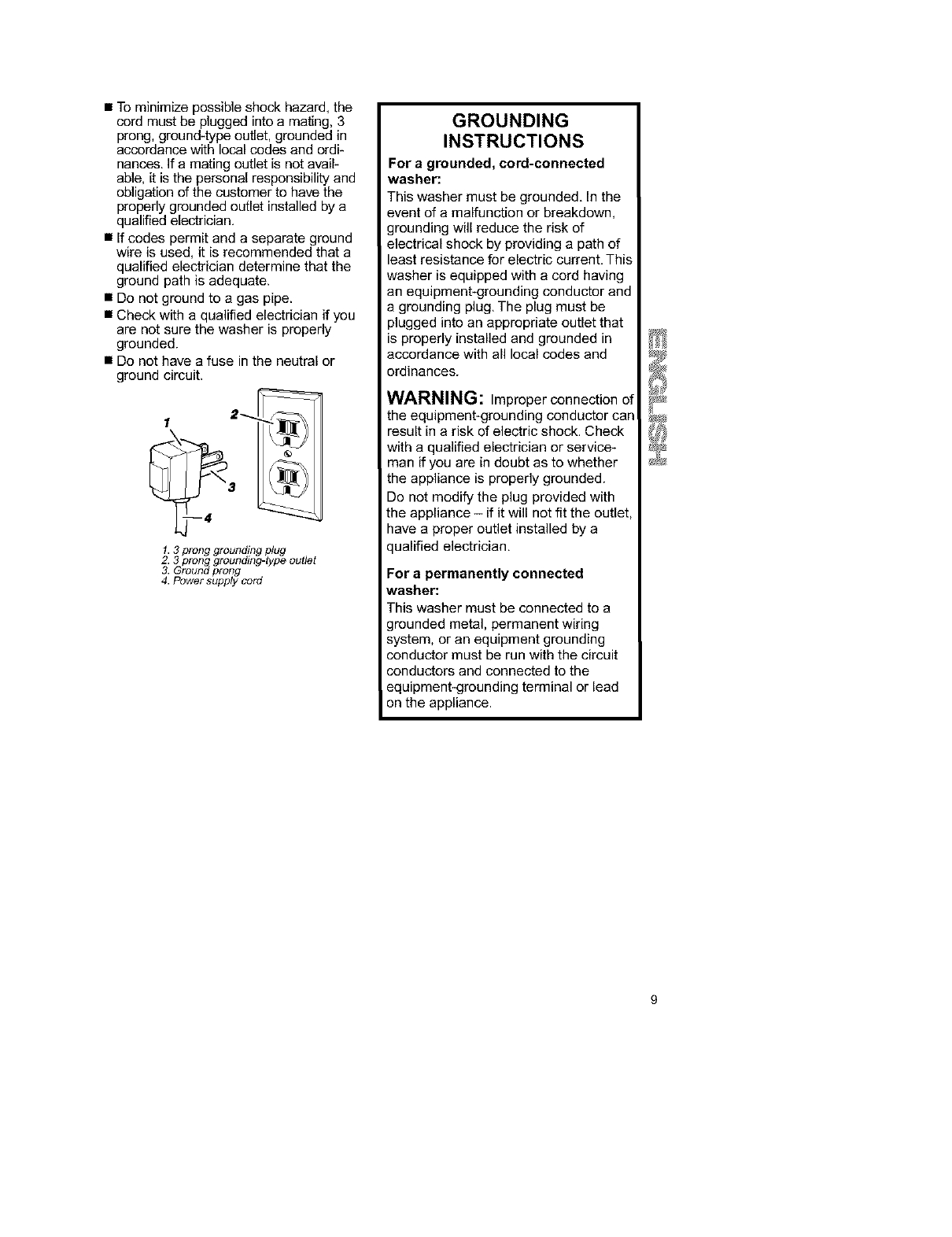
• Tominimizepossibleshockhazard,the
cordmustbepluggedintoamating,3
prong,ground-typeoutlet,groundedin
accordancewithlocalcodesandordF
nances.Ifamatingoutletisnotavail-
able,itisthepersonalresponsibilityand
obligationofthecustomertohavethe
properlygroundedoutletinstalledbya
qualifiedelectrician,
• Ifcodespermitanda separate ground
wire is used, it is recommended that a
qualified electrician determine that the
ground path is adequate.
• Do not ground to a gas pipe.
• Check with a qualified electrician if you
are not sure the washer is properly
grounded.
• Do not have a fuse in the neutral or
ground circuit.
1.3 prong grounding plug
2. 3 prong grounding-type outlet
3. Ground prong
4. Power supply cord
GROUNDING
INSTRUCTIONS
For a grounded, cord-connected
washer:
This washer must be grounded, In the
event of a malfunction or breakdown,
grounding will reduce the risk of
electrical shock by providing a path of
least resistance for electric current, This
washer is equipped with a cord having
an equipment-grounding conductor and
a grounding plug, The plug must be
plugged into an appropriate outlet that
is properly installed and grounded in
accordance with all local codes and
ordinances.
WARNING: Improper connection of
the equipment-grounding conductor can
result in a risk of electric shock. Check
with a qualified electrician or service-
man if you are in doubt as to whether
the appliance is properly grounded.
Do not modify the plug provided with
the appliance - if it will not fit the outlet
have a proper outlet installed by a
qualified electrician,
For a permanently connected
washer:
This washer must be connected to a
grounded metal, permanent wiring
system, or an equipment grounding
conductor must be run with the circuit
conductors and connected to the
equipment-grounding terminal or lead
on the appliance.
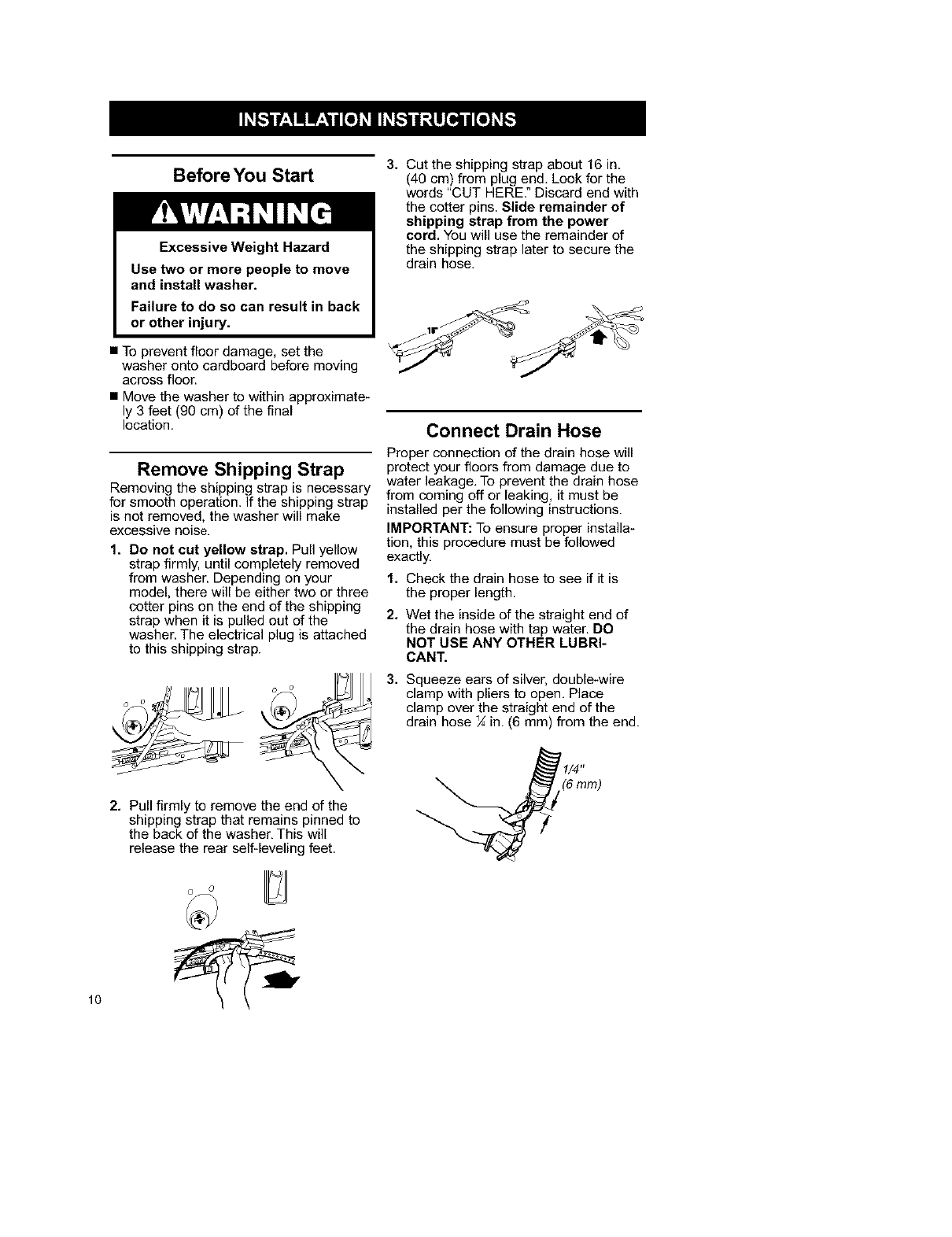
Before You Start
3. Cut the shipping strap about 16 in.
(40 cm) from plug end, Look for the
words "CUT HERE." Discard end with
the cotter pins. Slide remainder of
shipping strap from the power
cord. You will use the remainder of
the shipping strap later to secure the
drain hose.
• To prevent floor damage, set the
washer onto cardboard before moving
across floor.
• Move the washer to within approximate-
ly 3 feet (90 cm) of the final
location.
Remove Shipping Strap
Removing the shipping strap is necessary
for smooth operation. If the shipping strap
is not removed, the washer will make
excessive noise.
1, Do not cut yellow strap. Pull yellow
strap firmly, until completely removed
from washer. Depending on your
model, there will be either two or three
cotter pins on the end of the shipping
strap when it is pulled out of the
washer. The electrical plug is attached
to this shipping strap.
2, Pull firmly to remove the end of the
shipping strap that remains pinned to
the back of the washer, This will
release the rear selfqeveling feet.
Connect Drain Hose
Proper connection of the drain hose will
protect your floors from damage due to
water leakage, To prevent the drain hose
from coming off or leaking, it must be
installed per the following instructions.
IMPORTANT: To ensure proper installa-
tion, this procedure must be followed
exactly,
1. Check the drain hose to see if it is
the proper length.
2.
Wettheinsideofthestraightend
thed_inhose withtap water. DO
NOT USE ANY OTHER LUBRI-
CAN_
3.
Squeeze ears of silver, double-wire
clamp with pliers to open, Place
clamp over the straight end of the
drain hose _ in. (6 mm) from the end.
_ !/4"
___ Z_ (6 mm)
10
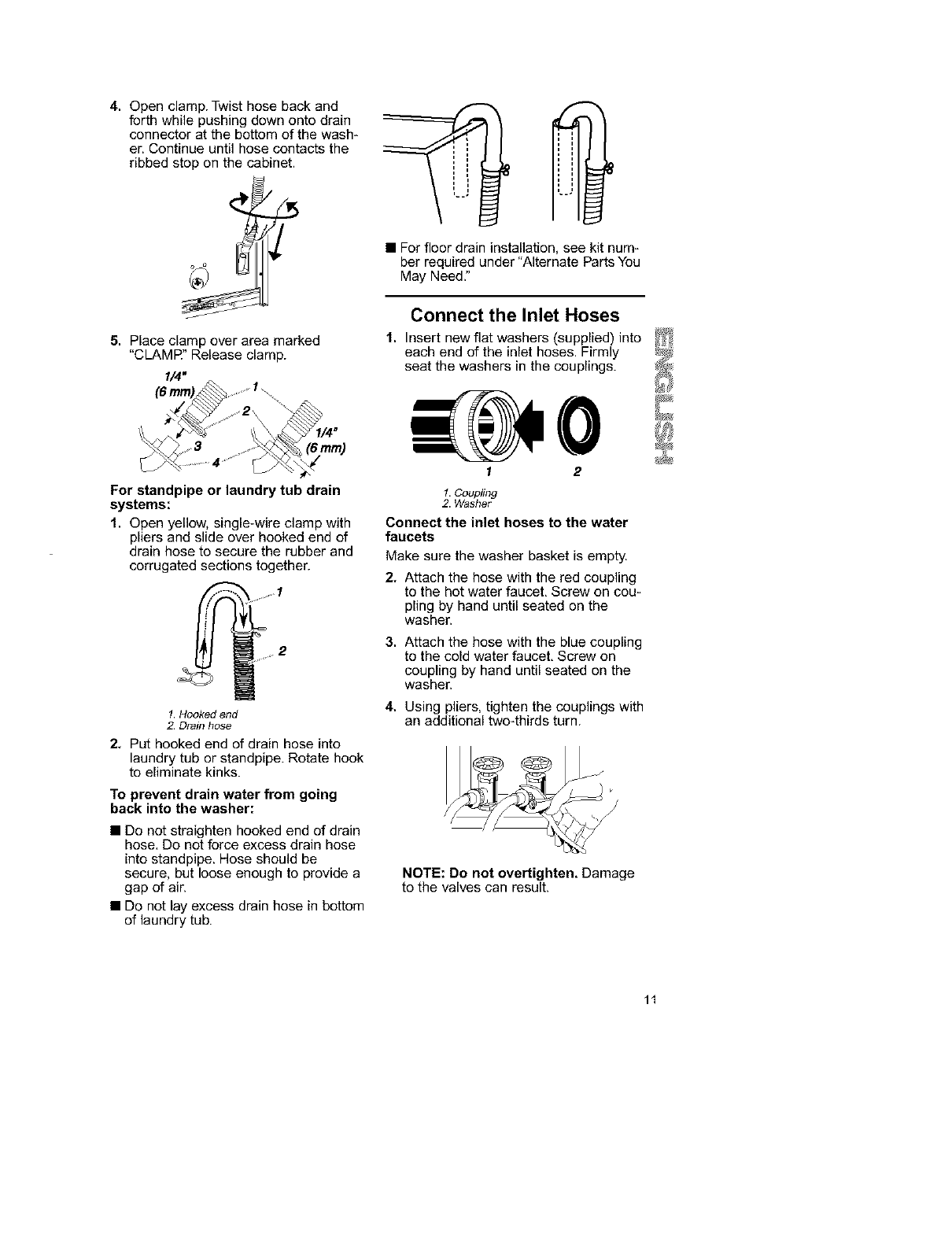
4. Open clamp. Twist hose back and
forth while pushing down onto drain
connector at the bottom of the wash-
er. Continue until hose contacts the
ribbed stop on the cabinet.
Y
5. Place clamp over area marked
"CLAMP." Release clamp.
1/4"
rnm)
For standpipe or laundry tub drain
systems:
1. Open yellow, single-wire clamp with
pliers and slide over hooked end of
drain hose to secure the rubber and
corrugated sections together.
1. Hooked end
2. Drain hose
2. Put hooked end of drain hose into
laundry tub or standpipe. Rotate hook
to eliminate kinks.
To prevent drain water from going
back into the washer:
• Do not straighten hooked end of drain
hose, Do not force excess drain hose
into standpipe. Hose should be
secure, but loose enough to provide a
gap of air.
• Do not lay excess drain hose in bottom
of laundry tub.
• For floor drain installation, see kit num-
ber required under "Alternate Parts You
May Need."
1.
Connect the Inlet Hoses
Insert new flat washers (supplied) into
each end of the inlet hoses. Firmly
seat the washers in the couplings.
1 2
1. Coupling
2. Washer
Connect the inlet hoses to the water
faucets
Make sure the washer basket is empty.
2. Attach the hose with the red coupling
to the hot water faucet, Screw on cou-
pling by hand until seated on the
washer.
3. Attach the hose with the blue coupling
to the cold water faucet, Screw on
coupling by hand until seated on the
washer.
4. Using pliers, tighten the couplings with
an additional two4hirds turn.
NOTE: Do not overtighten, Damage
to the valves can result.
11

12
Clear the water lines
5, Run water through both faucets and
inlet hoses, into a bucket or laundry
tub, to get rid of particles in the water
lines that might clog the inlet valve
screens.
Connect the inlet hoses to the washer
6, Attach the hose with the red coupling
to the HOT (bottom) inlet valve.
Attaching the red coupling first makes
it easier to tighten connection with
pliers, Screw on coupling by hand
until seated on the washer. Using pli-
ers, tighten the couplings with an
additional two4hirds turn.
NOTE: Do not overtighten. Damage
to the valves can result.
1
\
_2
1.Coldwater#getvalve(blue)
2.Hotwaterinletvalve(red)
NOTE: The inlet valve may be on the
right or the left side of the washer,
depending on your model.
7. Attach the hose with the blue cou-
pling to the COLD water (top) inlet
valve. Screw on coupling by hand
until seated on the washer. Using pli-
ers, tighten the couplings with an
additional two-thirds turn.
NOTE: Do not overtighten, Damage
to the valves can result.
Check for leaks
8. Turn on the water faucets and check
for leaks. A small amount of water
might enter the washer. You will drain
this later.
NOTE: Replace inlet hoses after 5
years of use to reduce the risk of hose
failure. Recordhose installation or
replacement dates for future reference.
• If you only connect one water
hose, you must cap off the remain-
ing water inlet port.
• Periodically inspect and replace
hoses if bulges, kinks, cuts, wear,
or leaks are found.
1.
2.
3.
Secure the Drain Hose
Drape the power cord over the console.
Remove any cardboard used to move
washer.
Locate the remaining piece of ship-
ping strap (not the end with the cotter
pins) from step 3 of "Remove
Shipping Strap." Use it to wrap the
drain hose together with the laundry
tub or standpipe. Push fastener into
the nearest hole in the shipping strap.
Remaining portion of Shipping Strap
4. Wrap the drain hose to the laundry
tub leg or standpipe with the tie strap.
(See illustration.)
If the washer faucets and the drain
standpipe are recessed, put the
hooked end of the drain hose in the
standpipe. Tightly wrap the tie strap
around the water inlet hoses and the
drain hose.
Level the Washer
Properly leveling your washer prevents
excessive noise and vibration.
Install the front leveling feet
1. Prop up the front of the washer about
4 in. (10.2 cm) with a wood block or
similar object. The block needs to
support the weight of the washer.
2. Screw the lock nut onto each foot to
within 1 in. (2.5 cm) of the base.
1 _
(2.5 cm)
!
3. Screw the feet into the correct holes
at the front corner of the washer until
the nuts touch the washen
NOTE: Do not tighten the nuts until
the washer is level.
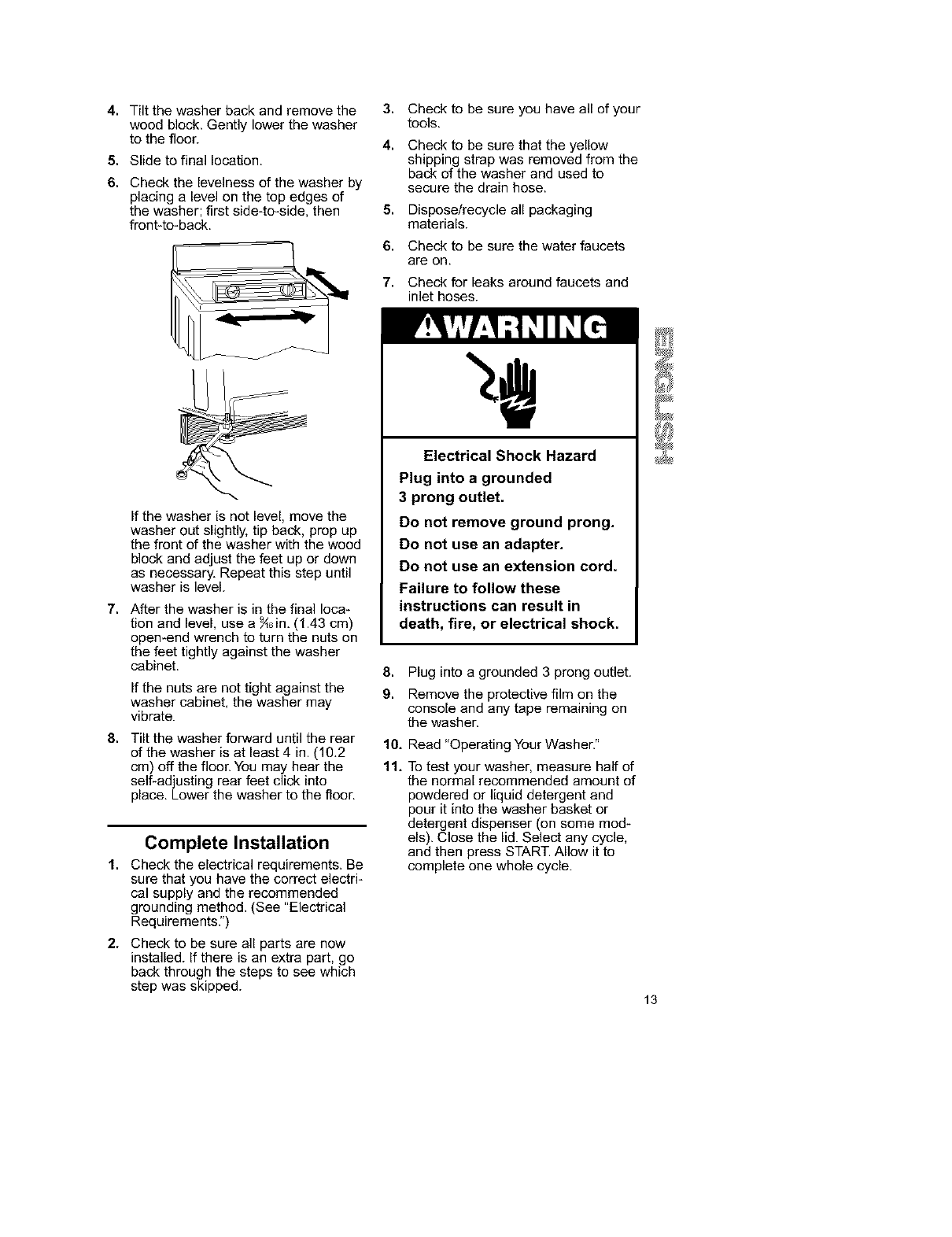
4. Tiltthewasherbackandremovethe 3.
woodblock.Gentlylowerthewasher
tothefloor. 4.
5. Slide to final location.
6. Check the levelness of the washer by
placing a level on the top edges of
the washer; first side-to-side, then
front4o-back.
5.
6.
7.
Check to be sure you have all of your
tools.
Check to be sure that the yellow
shipping strap was removed from the
back of the washer and used to
secure the drain hose.
Dispose/recycle all packaging
materials.
Check to be sure the water faucets
are on.
Check for leaks around faucets and
inlet hoses.
If the washer is not level, move the
washer out slightly, tip back, prop up
the front of the washer with the wood
block and adjust the feet up or down
as necessary, Repeat this step until
washer is level.
7. After the washer is in the final loca-
tion and level, use a _6in, (1.43 cm)
open-end wrench to turn the nuts on
the feet tightly against the washer
cabinet.
If the nuts are not tight against the
washer cabinet, the washer may
vibrate.
8. Tilt the washer forward until the rear
of the washer is at least 4 in. (10,2
cm) off the floor. You may hear the
self-adjusting rear feet click into
place. Lower the washer to the floor.
Complete Installation
1. Check the electrical requirements. Be
sure that you have the correct electri-
cal supply and the recommended
grounding method. (See "Electrical
Requirements.")
2, Check to be sure all parts are now
installed. If there is an extra part, go
back through the steps to see which
step was skipped.
Electrical Shock Hazard
Plug into a grounded
3 prong outlet.
Do not remove ground prong.
Do not use an adapter.
Do not use an extension cord.
Failure to follow these
instructions can result in
death, fire, or electrical shock.
8. Plug into a grounded 3 prong outlet.
9. Remove the protective film on the
console and any tape remaining on
the washer.
10, Read "Operating Your Washer."
11, To test your washer, measure half of
the normal recommended amount of
powdered or liquid detergent and
pour it into the washer basket or
detergent dispenser (on some mod-
els). Close the lid. Select any cycle,
and then press START. Allow it to
complete one whole cycle.
13
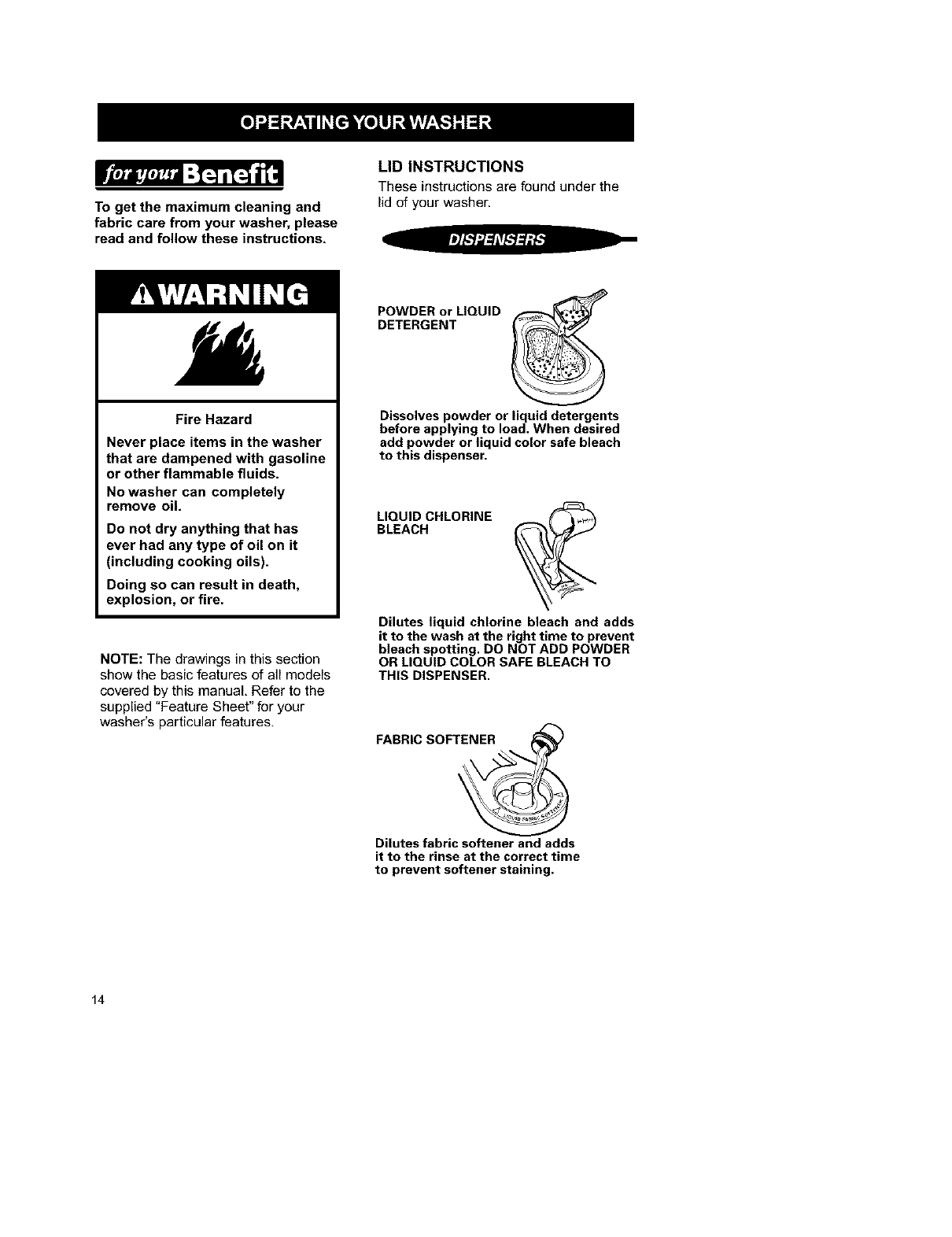
To get the maximum cleaning and
fabric care from your washer, please
read and follow these instructions,
LID INSTRUCTIONS
These instructions are found under the
lid of your washer.
Fire Hazard
Never place items in the washer
that are dampened with gasoline
or other flammable fluids.
No washer can completely
remove oil,
Do not dry anything that has
ever had any type of oil on it
(including cooking oils),
Doing so can result in death,
explosion, or fire.
NOTE: The drawings in this section
show the basic features of all models
covered by this manual, Refer to the
supplied "Feature Sheet" for your
washer's particular features.
POWDER or LIQUID ,,---_-_,.._,:_
DETERGENT
Dissolves powder or liquid detergents
before applying to load. When desired
add powder or liquid color safe bleach
to this dispenser.
BLEACHLIQUIDCHLORINE
Dilutes liquid chlorine bleach and adds
it to the wash at the right time to prevent
bleach spotting. DO NOT ADD POWDER
OR LIQUID COLOR SAFE BLEACH TO
THIS DISPENSER.
FABRICSOFTENER . _;_
Dilutes fabric softener and adds
it to the rinse at the correct time
to prevent softener staining.
14
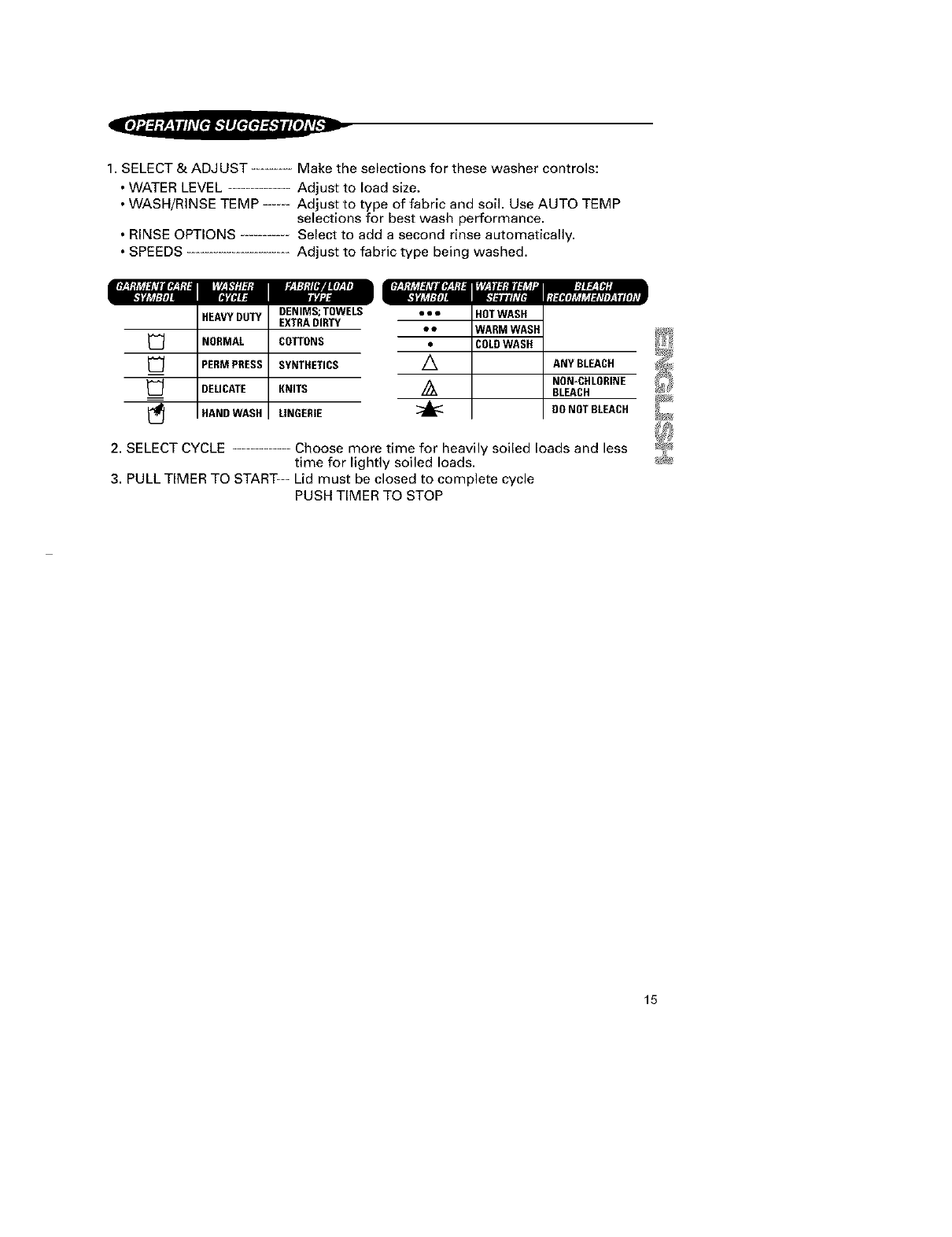
1. SELECT & ADJUST ......... Make the selections for these washer controls:
• WATER LEVEL Adjust to load size.
• WASH/RINSE TEMP ...... Adjust to type of fabric and soil. Use AUTO TEMP
selections for best wash performance.
• RINSE OPTIONS ........... Select to add a second rinse automatically.
• SPEEDS Adjust to fabric type being washed.
[ffzf;lJ_i3_IllfW,_f:t_l]lt_/,_lltl;ml,11JSr fll;F_-TH
HEAVY DUTY
NORMAL
PERM PRESS
DELICATE
HAND WASH
BEW,_T;tJ_ItI_IJfW_.F:t:I
DENIMS; TOWELS
EXTRADIRTY
COTTONS
SYNTHETICS
KNITS
LINGERIE
eee HOTWASH
ee WARM WASH
COLDWASH
/_ ANY BLEACH
/_ NON-CHLORINE
BLEACH
_j_ OONOTBLEACH
2. SELECT CYCLE Choose more time for heavily soiled loads and less
time for lightly soiled loads.
3. PULL TIMER TO START--- Lid must be closed to complete cycle
PUSH TIMER TO STOP
15
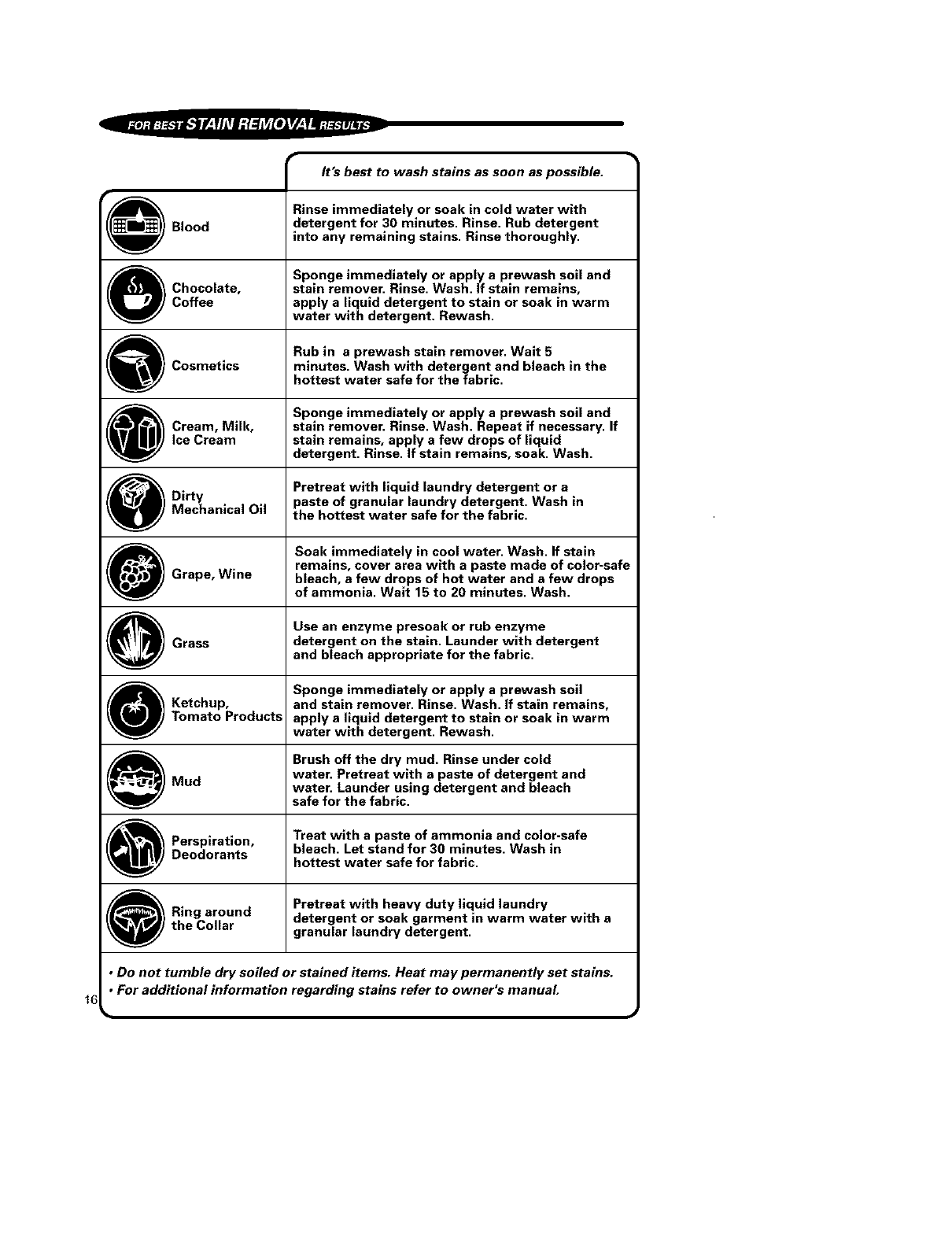
(_ Blood
_ _ _Chocolate,
Coffee
_ _ Cosmetics
_ ream, Milk,
Ice Cream
Dirty
W Mechanlcal Oil
_ _ Grape, Wine
_ I _ Ketchup,
W Tomato Products
Mud
_ erspiration,
Deodorants
Ringaround
_the Collar
It's best to wash stains as soon as possible.
Rinse immediately or soak in cold water with
detergent for 30 minutes. Rinse. Rub detergent
into any remaining stains. Rinse thoroughly.
Sponge immediately or apply a prewash soll and
stain remover. Rinse. Wash. If stain remains,
apply a liquid detergent to stain or soak in warm
water with detergent. Rewash.
Rub in a prewash stain remover. Wait 5
minutes. Wash with detergent and bleach in the
hottest water safe for the fabric.
Sponge immediately or apply a prewash soil and
stain remover. Rinse. Wash. Repeat if necessary. If
stain remains, apply a few drops of liquid
detergent. Rinse. If stain remains, soak. Wash.
Pretreat with liquid laundry detergent or a
paste of granular laundry detergent. Wash in
the hottest water safe for the fabric.
Soak immediately in cool water. Wash. If stain
remains, cover area with a paste made of color=safe
bleach, a few drops of hot water and a few drops
of ammonia. Wait 15 to 20 minutes. Wash.
Use an enzyme presoak or rub enzyme
detergent on the stain. Launder with detergent
and bleach appropriate for the fabric.
Sponge immediately or apply a prewash soil
and stain remover. Rinse. Wash. If stain remains,
apply a liquid detergent to stain or soak in warm
water with detergent. Rewash.
Brush off the dry mud. Rinse under cold
water. Pretreat with a paste of detergent and
water. Launder using detergent and bleach
safe for the fabric.
Treat with a paste of ammonia and color-safe
bleach. Let stand for 30 minutes. Wash in
hottest water safe for fabric.
Pretreat with heavy duty liquid laundry
detergent or soak garment in warm water with a
granular laundry detergent.
• Do not tumble dry soiled or stained items. Heat may permanently set stains.
• For additional information regarding stains refer to owner's manual.
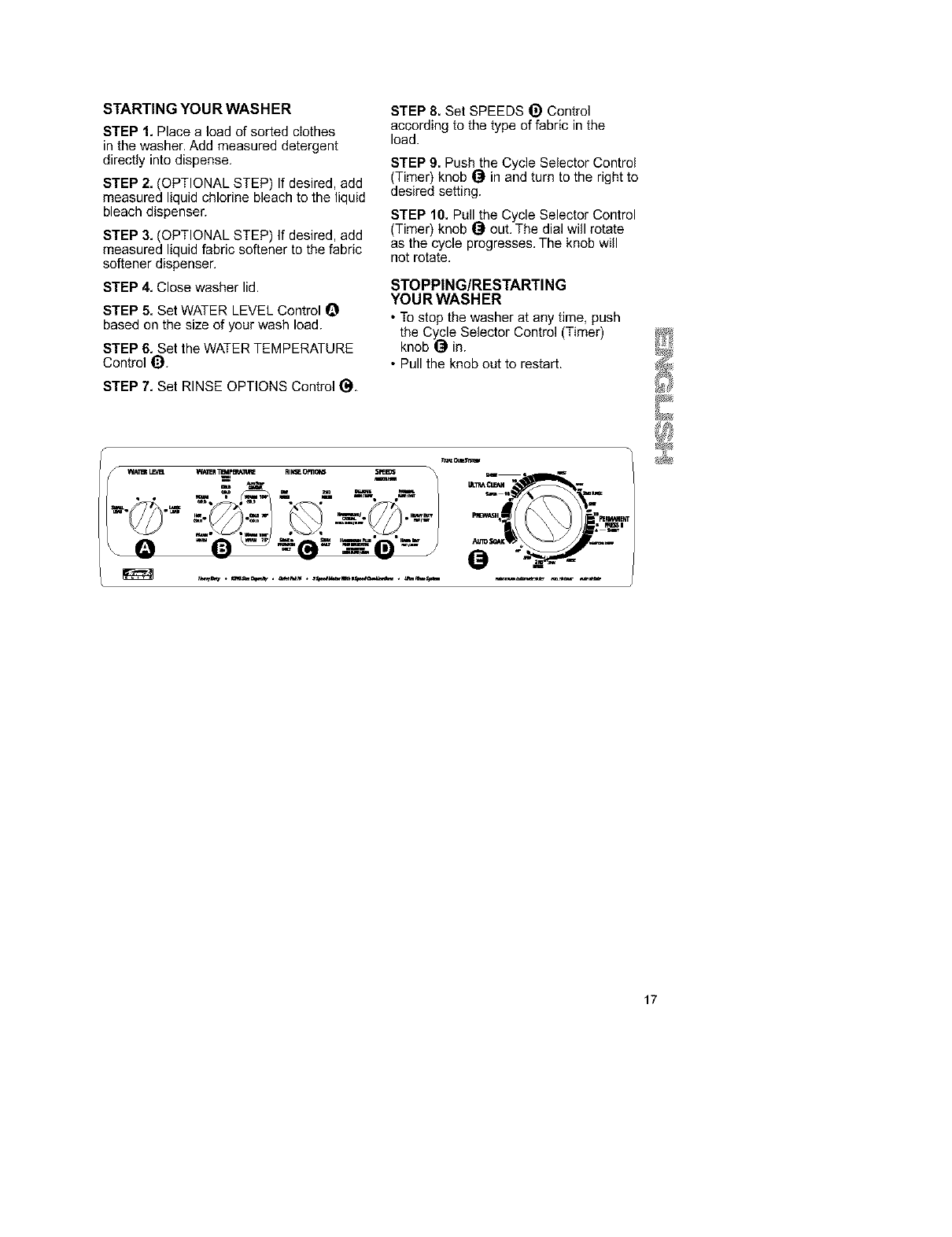
STARTING YOUR WASHER STEP 8. Set SPEEDS (_) Control
according to the type of fabric in the
load.
STEP 1. Place a load of sorted clothes
in the washer. Add measured detergent
directly into dispense.
STEP 2. (OPTIONAL STEP) If desired, add
measured liquid chlorine bleach to the liquid
bleach dispenser.
STEP 3. (OPTIONAL STEP) If desired, add
measured liquid fabric softener to the fabric
softener dispensen
STEP 4. Close washer lid.
STEP 5. Set WATER LEVEL Control Q
based on the size of your wash load.
STEP 6. Set the WATER TEMPERATURE
Control (_.
STEP 7. Set RINSE OPTIONS Control (_.
STEP 9. Push the Cycle Selector Control
(Timer) knob (_ in and turn to the right to
desired setting.
STEP 10. Pull the Cycle Selector Control
(Timer) knob _ out. The dial will rotate
as the cycle progresses. The knob will
not rotate.
STOPPING/RESTARTING
YOUR WASHER
• To stop the washer at any time, push
the Cycle Selector Control (Timer)
knob @ in.
• Pull the knob out to restart.
W/_B TIBdF_III_ It111213pi]lli%ll SREB_
=m _ L'I.T_,Ctr_t
"e = -"Ilil -" /
-- -- ----'11"--v O "_
17
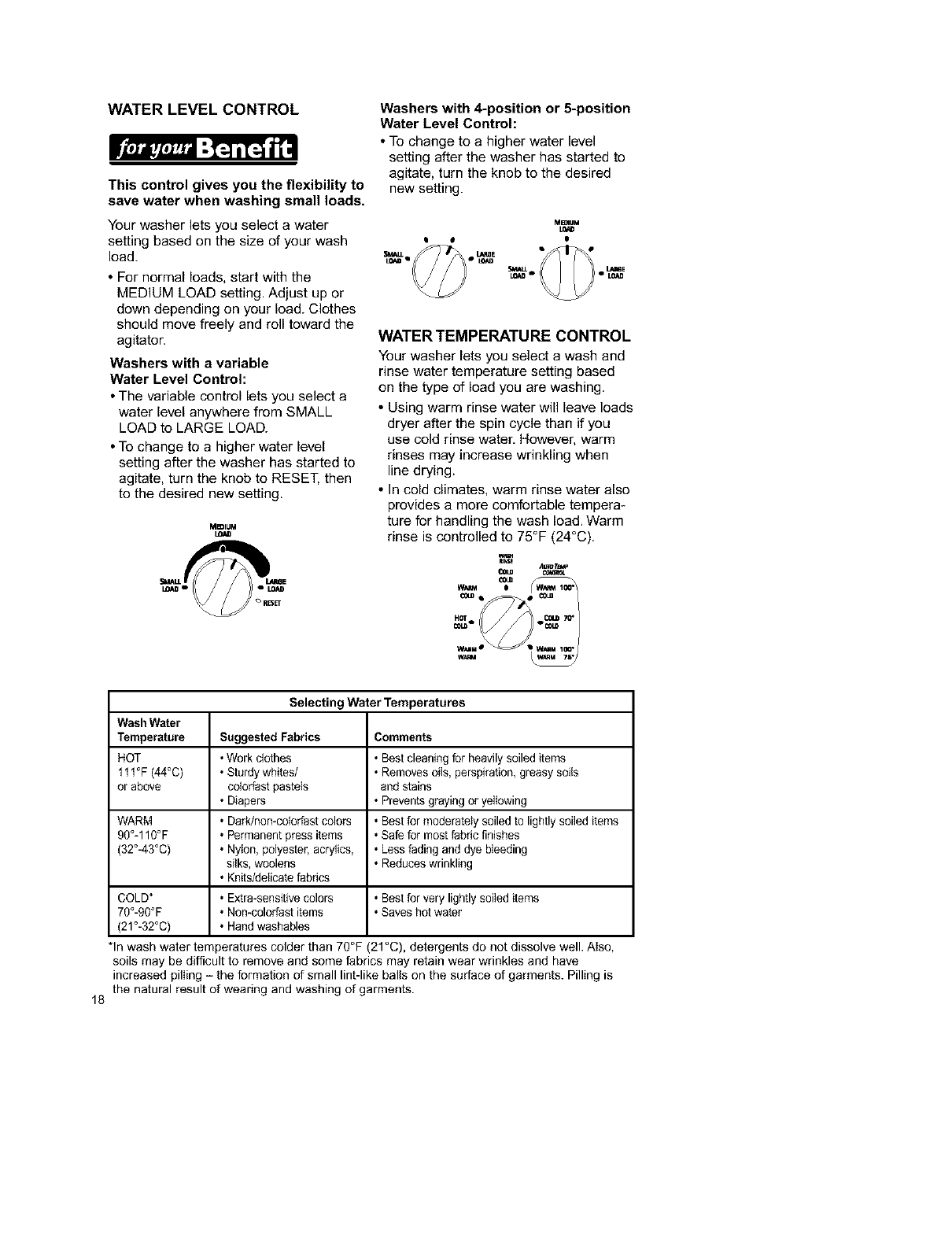
WATER LEVEL CONTROL
This control gives you the flexibility to
save water when washing small loads,
Your washer lets you select a water
setting based on the size of your wash
load.
• For normal loads, start with the
MEDIUM LOAD setting. Adjust up or
down depending on your load. Clothes
should move freely and roll toward the
agitator.
Washers with a variable
Water Level Control:
• The variable control lets you select a
water level anywhere from SMALL
LOAD to LARGE LOAD.
• To change to a higher water level
setting after the washer has started to
agitate, turn the knob to RESET, then
to the desired new setting.
MB01UM
Washers with 4-position or 5-position
Water Level Control:
• To change to a higher water level
setting after the washer has started to
agitate, turn the knob to the desired
new setting.
ME_IUM
LOAD
WATER TEMPERATURE CONTROL
Your washer lets you select a wash and
rinse water temperature setting based
on the type of load you are washing.
• Using warm rinse water will leave loads
dryer after the spin cycle than if you
use cold rinse water. However, warm
rinses may increase wrinkling when
line drying.
• In cold climates, warm rinse water also
provides a more comfortable tempera-
ture for handling the wash load. Warm
rinse is controlled to 75°F (24°C).
AUr#_
COW COM_
¢131J_Q •
Selecting Water Temperatures
Wash Water
Temperature Suggested Fabrics Comments
HOT • Work clothes • Best cleaning for heavily soiled items
111°F (44°C) ° Sturdy whites/ • Removes oils, perspiration, greasy soils
or above colorfast pastels and stains
• Diapers • Prevents graying or yellowing
WARM ° Dark/non-colorfast colors • Best for moderately soiled to lightly soiled items
90°-110°F ° Permanent press items • Safe for most fabric finishes
(32°-43°C) • Nylon, polyester, acrylics, • Less fading and dye bleeding
silks, woolens • Reduces wrinkling
• Knits/delicate fabrics
COLD* ° Extra-sensitive colors • Best for very lightly soiled items
70°-90°F ° Non-colorfast items • Saves hot water
(21°-32°C) • Hand washables
*In wash water temperatures colder than 70°F (21°C), detergents do not dissolve well. Also,
soils may be difficult to remove and some fabrics may retain wear wrinkles and have
increased pilling - the formation of small lint-like balls on the surface of garments. Pilling is
the natural result of wearing and washing of garments.
18
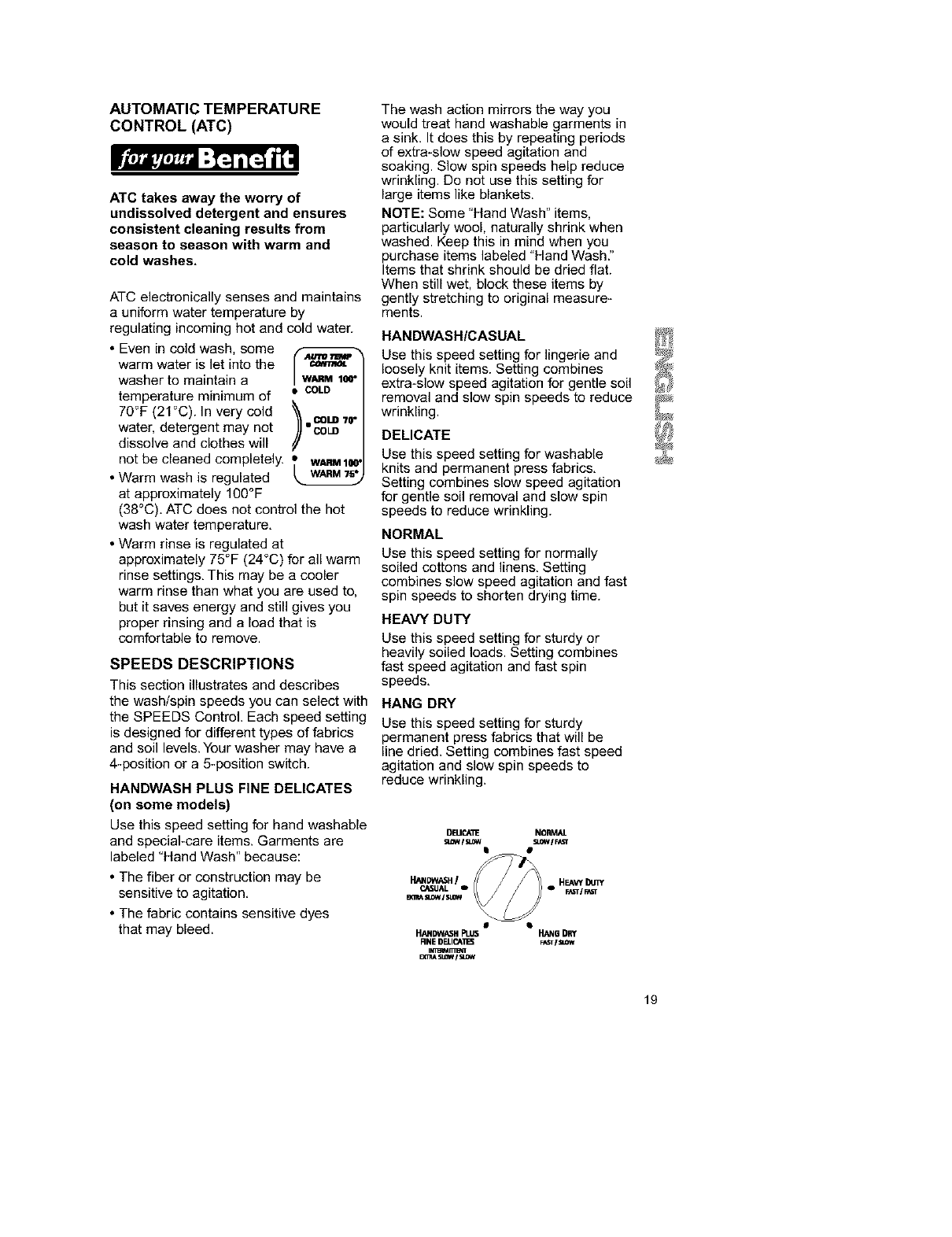
AUTOMATIC TEMPERATURE
CONTROL (ATC)
ATC takes away the worry of
undissolved detergent and ensures
consistent cleaning results from
season to season with warm and
cold washes,
ATC electronically senses and maintains
a uniform water temperature by
regulating incoming hot and cold water.
• Even in cold wash, some
warm water is let into the
washer to maintain a
temperature minimum of .• COLD
70°F (21°C). In very cold _.COLD 70"
water, detergent may not COLD
//
dissolve and clothes will
not be cleaned completely. • WARMI_
• Warm wash is regulated
at approximately 100°F
(38°C). ATC does not control the hot
wash water temperature.
• Warm rinse is regulated at
approximately 75°F (24°C) for all warm
rinse settings. This may be a cooler
warm rinse than what you are used to,
but it saves energy and still gives you
proper rinsing and a load that is
comfortable to remove.
SPEEDS DESCRIPTIONS
This section illustrates and describes
the wash/spin speeds you can select with
the SPEEDS Control. Each speed setting
is designed for different types of fabrics
and soil levels. Your washer may have a
4-position or a 5-position switch.
HANDWASH PLUS FINE DELICATES
(on some models)
Use this speed setting for hand washable
and special-care items. Garments are
labeled "Hand Wash" because:
• The fiber or construction may be
sensitive to agitation.
• The fabric contains sensitive dyes
that may bleed.
The wash action mirrors the way you
would treat hand washable garments in
a sink. It does this by repeating periods
of extra-slow speed agitation and
soaking. Slow spin speeds help reduce
wrinkling. Do not use this setting for
large items like blankets.
NOTE: Some "Hand Wash" items,
particularly wool, naturally shrink when
washed. Keep this in mind when you
purchase items labeled "Hand Wash."
Items that shrink should be dried flat.
When still wet, block these items by
gently stretching to original measure-
ments.
HANDWASH/CASUAL
Use this speed setting for lingerie and
loosely knit items. Setting combines
extra-slow speed agitation for gentle soil
removal and slow spin speeds to reduce
wrinkling.
DELICATE
Use this speed setting for washable
knits and permanent press fabrics.
Setting combines slow speed agitation
for gentle soil removal and slow spin
speeds to reduce wrinkling.
NORMAL
Use this speed setting for normally
soiled cottons and linens. Setting
combines slow speed agitation and fast
spin speeds to shorten drying time.
HEAVY DUTY
Use this speed setting for sturdy or
heavily soiled loads. Setting combines
fast speed agitation and fast spin
speeds.
HANG DRY
Use this speed setting for sturdy
permanent press fabrics that will be
line dried. Setting combines fast speed
agitation and slow spin speeds to
reduce wrinkling.
DEB_ NORMN.
SLOWI_ SL0WI_
HEAVYDUlY
HANDWASII PLUS klAN6 DRY
RNE DELIP_.]I_ r_'T I _=W
ImffRNl
B(mA SLOW/ SLOW
19
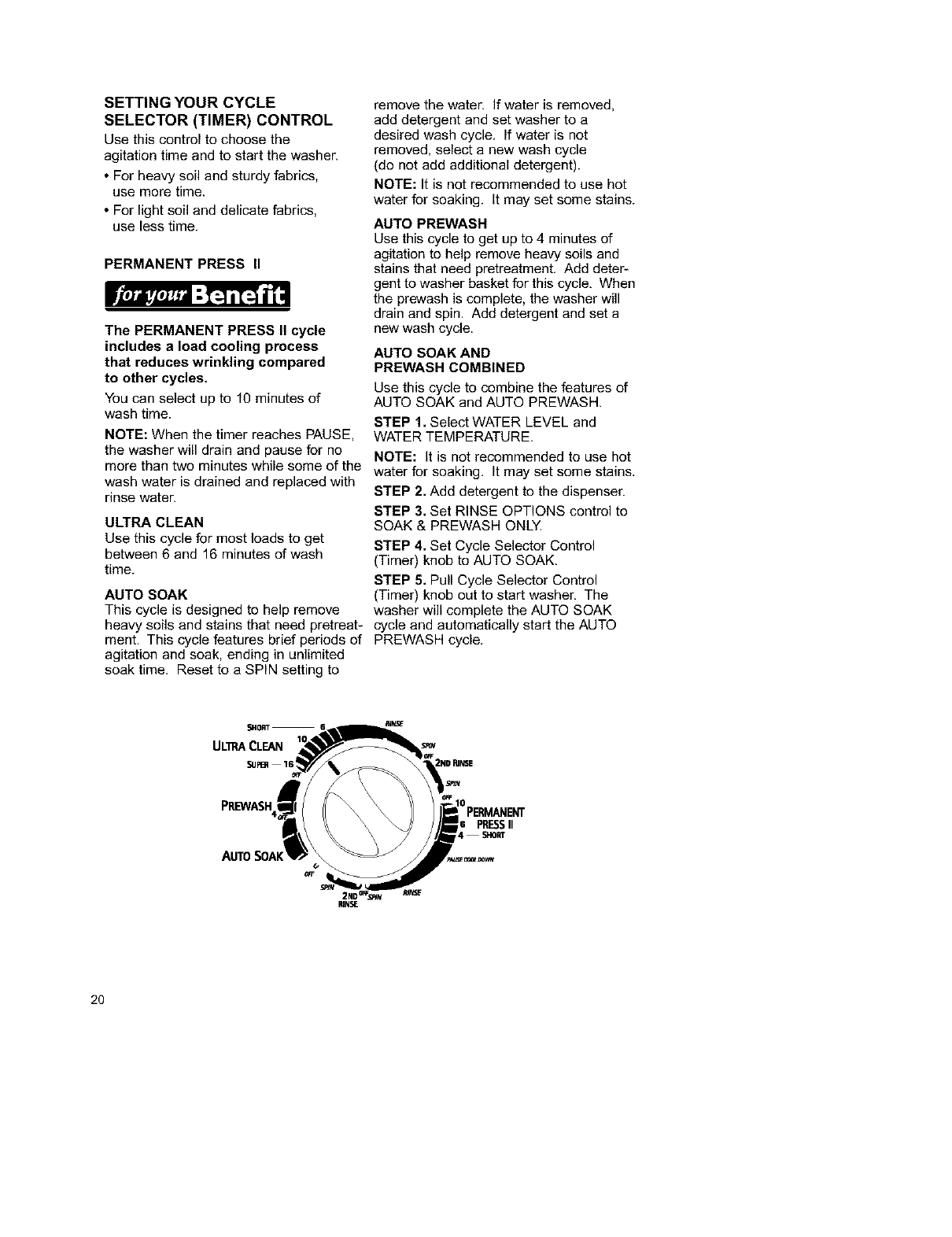
SETTING YOUR CYCLE
SELECTOR (TIMER) CONTROL
Use this control to choose the
agitation time and to start the washer.
• For heavy soil and sturdy fabrics,
use more time.
• For light soil and delicate fabrics,
use less time.
PERMANENT PRESS II
The PERMANENT PRESS II cycle
includes a load cooling process
that reduces wrinkling compared
to other cycles,
You can select up to 10 minutes of
wash time.
NOTE: When the timer reaches PAUSE,
the washer will drain and pause for no
more than two minutes while some of the
wash water is drained and replaced with
rinse water.
ULTRA CLEAN
Use this cycle for most loads to get
between 6 and 16 minutes of wash
time.
AUTO SOAK
This cycle is designed to help remove
heavy soils and stains that need pretreat-
ment. This cycle features brief periods of
agitation and soak, ending in unlimited
soak time. Reset to a SPIN setting to
remove the water. If water is removed,
add detergent and set washer to a
desired wash cycle, If water is not
removed, select a new wash cycle
(do not add additional detergent).
NOTE: It is not recommended to use hot
water for soaking, It may set some stains.
AUTO PREWASH
Use this cycle to get up to 4 minutes of
agitation to help remove heavy soils and
stains that need pretreatment, Add deter-
gent to washer basket for this cycle, When
the prewash is complete, the washer will
drain and spin. Add detergent and set a
new wash cycle.
AUTO SOAK AND
PREWASHCOMBINED
Use this cycle to combine the features of
AUTO SOAK and AUTO PREWASH.
STEP 1. Select WATER LEVEL and
WATER TEMPERATURE.
NOTE: It is not recommended to use hot
water for soaking, It may set some stains,
STEP 2. Add detergent to the dispenser.
STEP 3. Set RINSE OPTIONS control to
SOAK & PREWASH ONLY.
STEP 4. Set Cycle Selector Control
(Timer) knob to AUTO SOAK.
STEP 5. Pull Cycle Selector Control
(Timer) knob out to start washer, The
washer will complete the AUTO SOAK
cycle and automatically start the AUTO
PREWASH cycle.
2ND IUNSE
PREWASH
I°PERMANENT
s PRESSII
SHORT
RINSE
20

CYCLE/OPTIONS DESCRIPTIONS
You may add options to your wash cycle. The chart below shows you the proper set-
tings for your Cycle Selector Control (Timer) and RINSE OPTIONS Control. The Cycle
Selector Control needs to be set where you want the cycle to start and the RINSE
OPTIONS Control needs to be set where you want the cycle to stop. (Example: If you
want a second rinse added to the ULTRA CLEAN cycle, you would set the Cycle
Selector Control to ULTRA CLEAN _ and the RINSE OPTIONS Control to 2ND
RINSE O.
CYCLE SELECTOR CONTROL (TIMER)
RINSE OPTIONS CONTROL
Q
\\
ONE
RINSE
Q •
SONC&
0
/
2ND
RINSE
Desired Set Cycle Selector Set RinseOptions Add
Washer Action Control (Timer) On Control On Detergentto:
Washand Desiredwash ONE RINSE Q Dispenser
One Rinse cycle Q or O
Washeragitates,rinses,and spins.
Wash and Desired wash 2ND RINSE Q Dispenser
2nd Rinse cycle _ or O
Washeragitates,rinses,and spinsfollowedby a seconddeep rinse.
Rinse & Spin RINSE _ ONE RINSE Q De not add
detergent.
Washeragitates,drains,and spins.
Spin SPIN _ ONE RINSE Q Donot add
detergent.
Washerspins.
Soak Only AUTOSOAK _) SOAK ONLY (_ Basket
(unlimitedsoak time)
Washerwill alternateperiodsof agitationand soakingfor a few minutes.
Clotheswill continueto soakfor an unlimitedperiod.
Soak & Prewash AUTOSOAK _) SOAK & PREWASH Basket
(24 minutes) ONLY _)
Washerwil] alternateperiodsof agitationand soaking.
CycleSelectorControl(Timer)wil] go directlyintothe PREWASHcycle.
Prewash Only PREWASH _1 SOAK & PREWASH Basket
ONLY•
Washeragitates,drains,and spins.
NOTE:PrewashOnlyandSoak& Prewashshouldbefoltowedbya mainwashcyclewithadditionaldetergent
added.SoakOntyshouldbefollowedbya mainwashcyclewithoutadditionaldetergent.
21
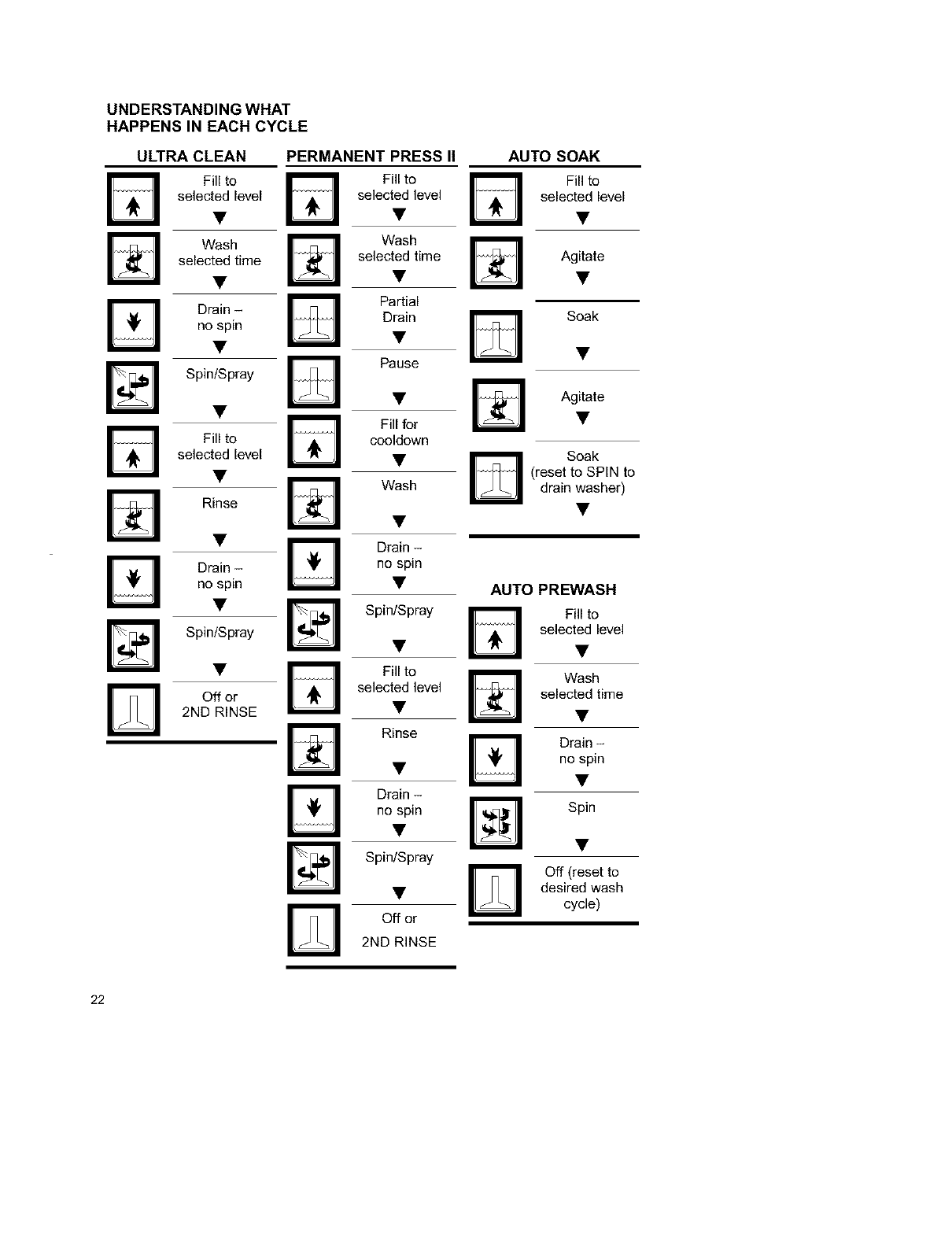
UNDERSTANDING WHAT
HAPPENS IN EACH CYCLE
ULTRA CLEAN PERMANENT PRESS II
r_! Fill to _ Fill to
selected level selected level
Wash
selected time
Drain -
no spin
Spin/Spray
Fill to
selected level
Rinse
Drain -
no spin
Spin/Spray
Off or
2ND RINSE
Wash
selected time
Partial
Drain
Pause
Fill for
ceoldown
Wash
Drain -
no spin
Spin/Spray
Fill to
selected level
Rinse
rq
Drain -
no spin
Spin/Spray
Off or
2ND RINSE
AUTO SOAK
Fill to
selected level
Agitate
Soak
Agitate
Soak
(reset to SPIN to
drain washer)
AUTO PREWASH
Fill to
selected level
Wash
selected time
Drain -
no spin
Spin
Off (reset to
desired wash
cycle)
22
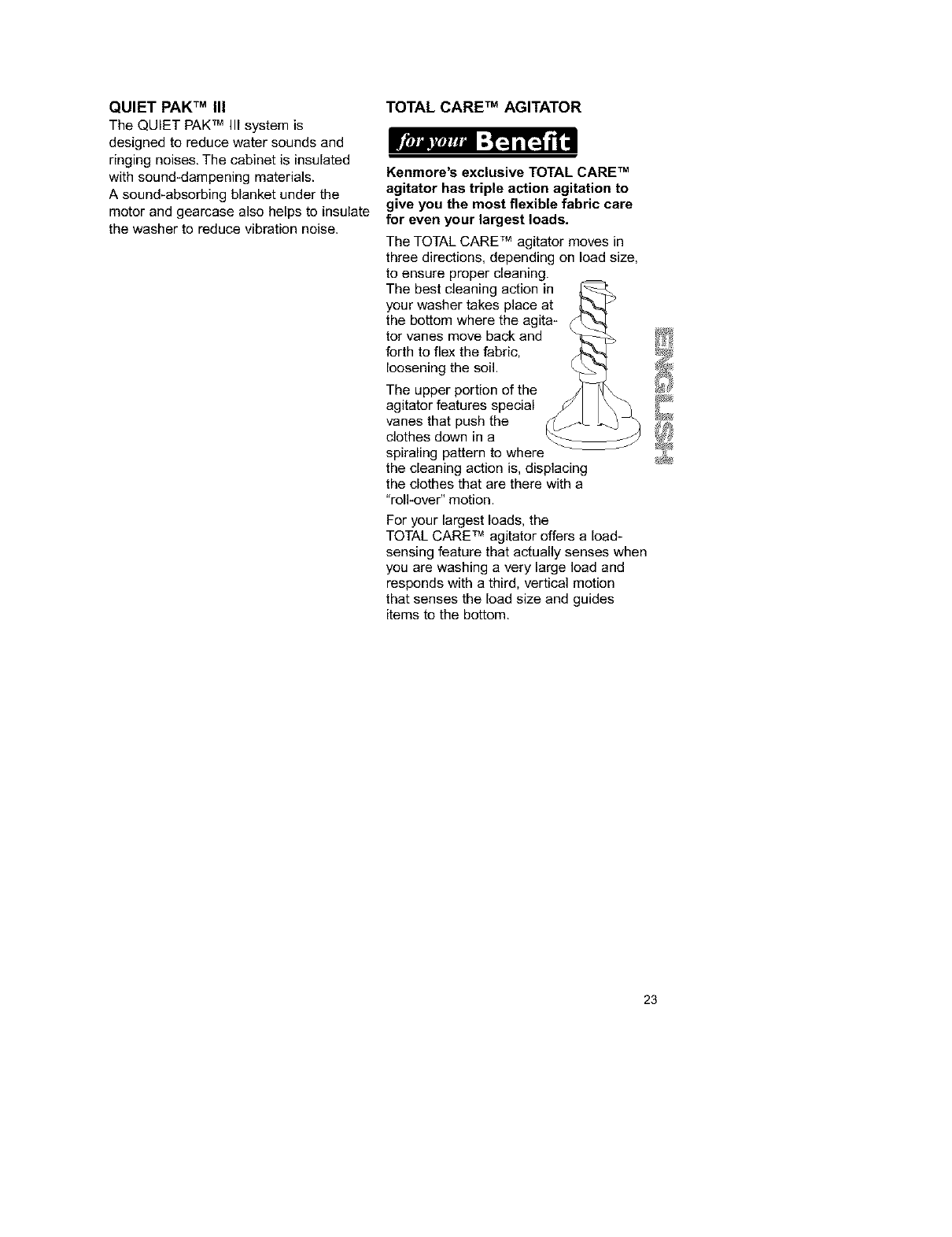
QUIET PAK TM III
The QUIET PAKTM III system is
designed to reduce water sounds and
ringing noises. The cabinet is insulated
with sound-dampening materials.
A sound-absorbing blanket under the
motor and gearcase also helps to insulate
the washer to reduce vibration noise.
TOTAL CARE TM AGITATOR
Kenmore's exclusive TOTAL CARE TM
agitator has triple action agitation to
give you the most flexible fabric care
for even your largest loads.
The TOTAL CARE TM agitator moves in
three directions, depending on load size
to ensure proper cleaning.
The best cleaning action in
your washer takes place at
the bottom where the agita-
tor vanes move back and
forth to flex the fabric,
loosening the soil.
The upper portion of the
agitator features special
vanes that push the H
clothes down in a
spiraling pattern to where
the cleaning action is, displacing
the clothes that are there with a
"roll-ever" motion.
For your largest loads, the
TOTAL CARE TM agitator offers a load-
sensing feature that actually senses when
you are washing a very large load and
responds with a third, vertical motion
that senses the load size and guides
items to the bottom.
23
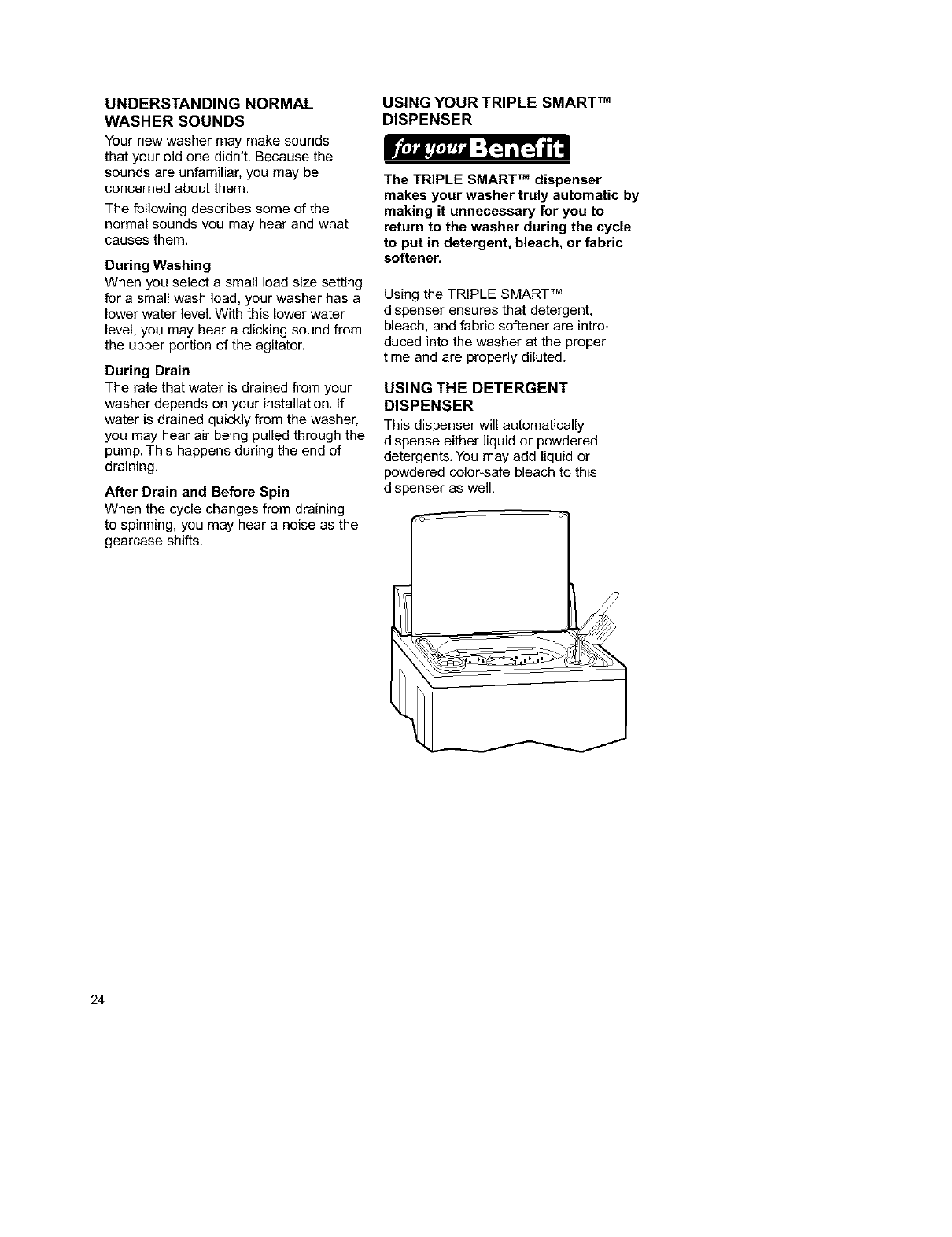
UNDERSTANDING NORMAL
WASHER SOUNDS
Your new washer may make sounds
that your old one didn't. Because the
sounds are unfamiliar, you may be
concerned about them.
The following describes some of the
normal sounds you may hear and what
causes them.
During Washing
When you select a small load size setting
for a small wash load, your washer has a
lower water level, With this lower water
level, you may hear a clicking sound from
the upper portion of the agitator.
During Drain
The rate that water is drained from your
washer depends on your installation, If
water is drained quickly from the washer,
you may hear air being pulled through the
pump. This happens during the end of
draining,
After Drain and Before Spin
When the cycle changes from draining
to spinning, you may hear a noise as the
gearcase shifts.
USING YOUR TRIPLE SMART TM
DISPENSER
The TRIPLE SMART TM dispenser
makes your washer truly automatic by
making it unnecessary for you to
return to the washer during the cycle
to put in detergent, bleach, or fabric
softener,
Using the TRIPLE SMART TM
dispenser ensures that detergent,
bleach, and fabric softener are intro-
duced into the washer at the proper
time and are properly diluted.
USING THE DETERGENT
DISPENSER
This dispenser will automatically
dispense either liquid or powdered
detergents. You may add liquid or
powdered color-safe bleach to this
dispenser as well.
24
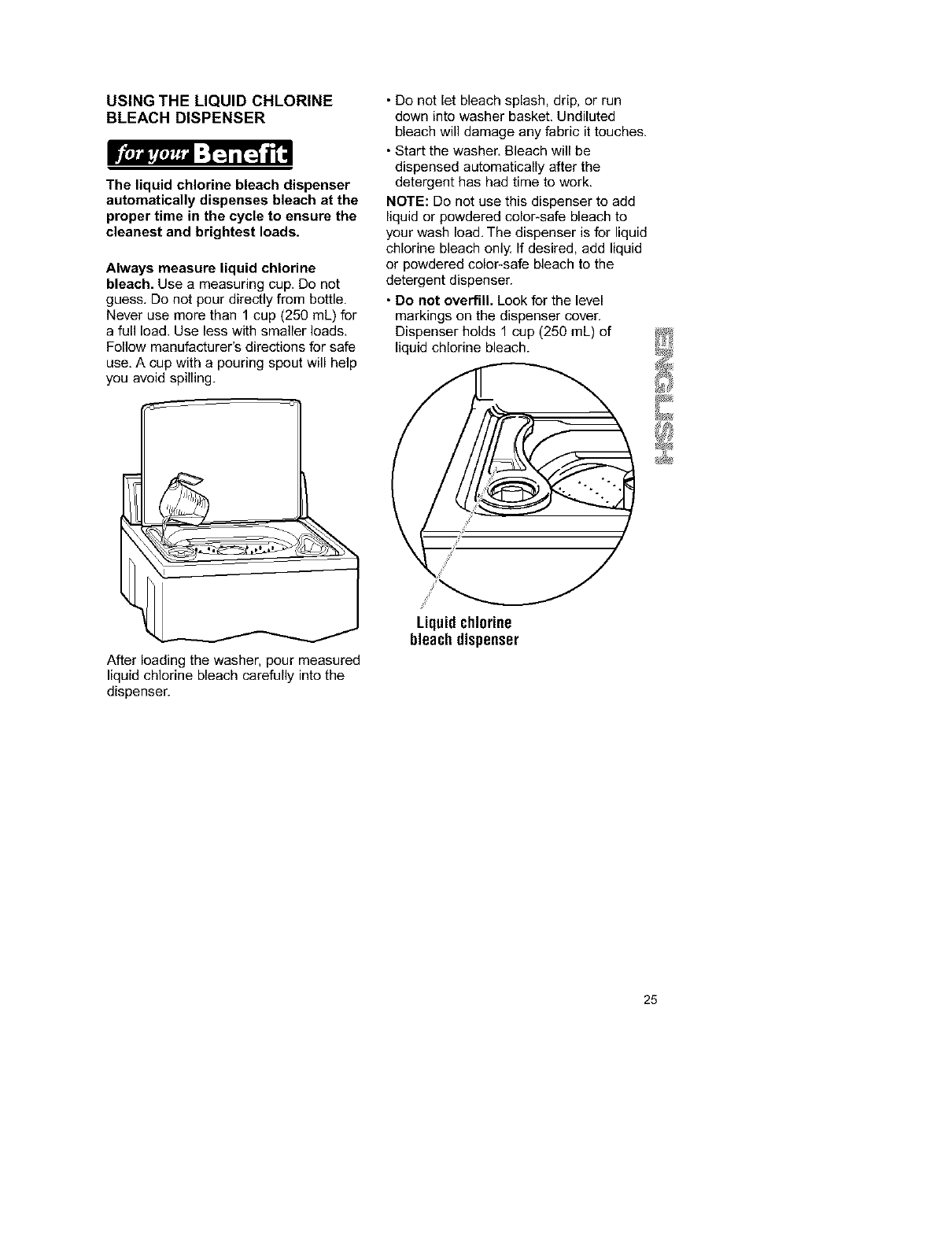
USING THE LIQUID CHLORINE
BLEACH DISPENSER
The liquid chlorine bleach dispenser
automatically dispenses bleach at the
proper time in the cycle to ensure the
cleanest and brightest loads.
Always measure liquid chlorine
bleach. Use a measuring cup. Do not
guess, Do not pour directly from bottle.
Never use more than 1 cup (250 mL) for
a full load. Use less with smaller loads,
Follow manufacturer's directions for safe
use, A cup with a pouring spout will help
you avoid spilling.
• Do not let bleach splash, drip, or run
down into washer basket, Undiluted
bleach will damage any fabric it touches.
• Start the washer, Bleach will be
dispensed automatically after the
detergent has had time to work.
NOTE: Do not use this dispenser to add
liquid or powdered color-safe bleach to
your wash load, The dispenser is for liquid
chlorine bleach only, If desired, add liquid
or powdered color*safe bleach to the
detergent dispenser.
• Do not overfill. Look for the level
markings on the dispenser cover,
Dispenser holds 1 cup (250 mL) of
liquid chlorine bleach.
After loading the washer, pour measured
liquid chlorine bleach carefully into the
dispenser.
Liquidchlorine
bleachdispenser
25
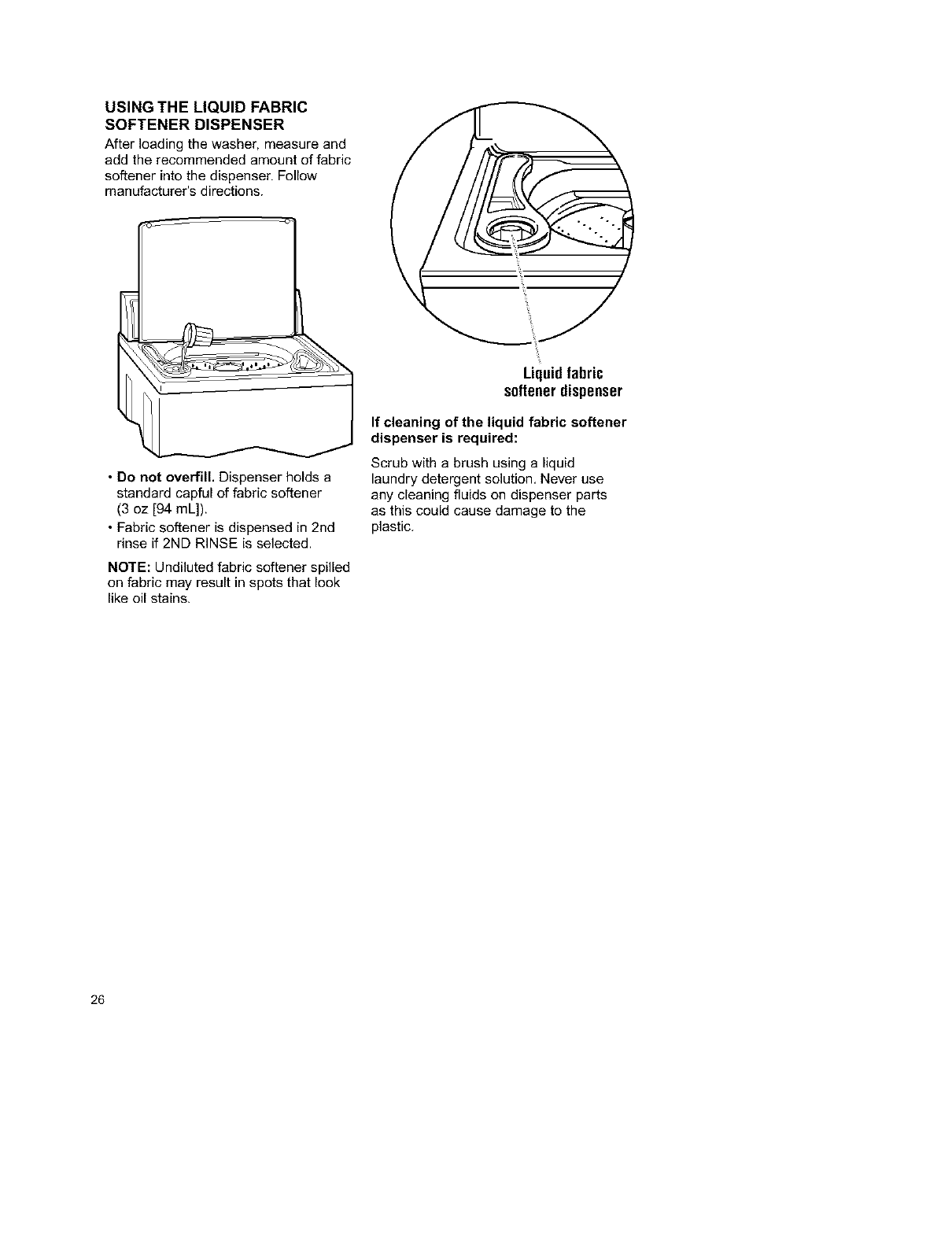
USING THE LIQUID FABRIC
SOFTENER DISPENSER
After loading the washer, measure and
add the recommended amount of fabric
softener into the dispenser. Follow
manufacturer's directions.
• Do not overfill. Dispenser holds a
standard capful of fabric softener
(3 oz [94 mL]).
• Fabric softener is dispensed in 2nd
rinse if 2ND RINSE is selected.
NOTE: Undiluted fabric softener spilled
on fabric may result in spots that look
like oil stains.
Liquidfabric
softenerdispenser
If cleaning of the liquid fabric softener
dispenser is required:
Scrub with a brush using a liquid
laundry detergent solution, Never use
any cleaning fluids on dispenser parts
as this could cause damage to the
plastic.
26
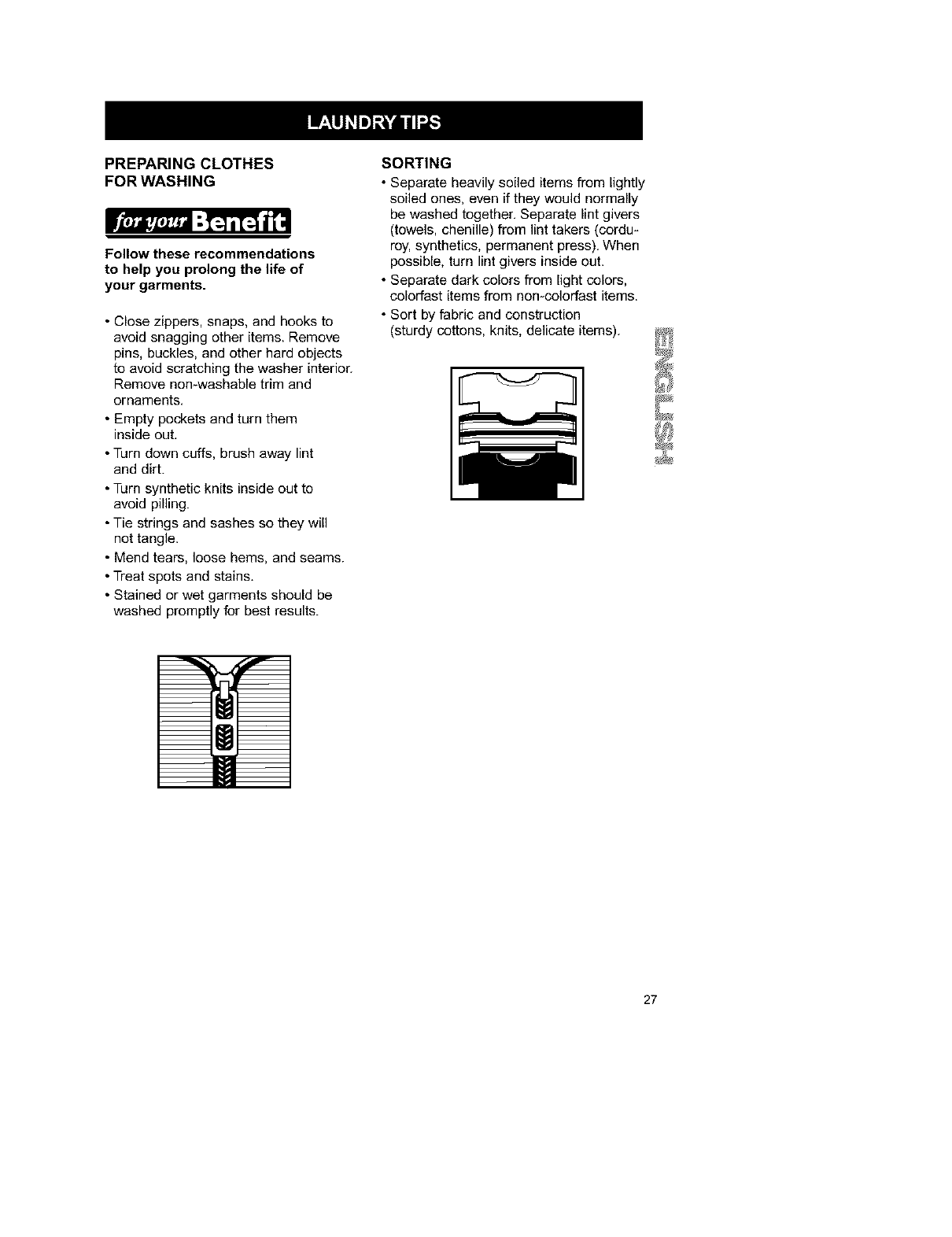
PREPARING CLOTHES
FOR WASHING
Follow these recommendations
to help you prolong the life of
your garments.
• Close zippers, snaps, and hooks to
avoid snagging other items. Remove
pins, buckles, and other hard objects
to avoid scratching the washer interior.
Remove non-washable trim and
ornaments,
• Empty pockets and turn them
inside out,
• Turn down cuffs, brush away lint
and dirt.
• Turn synthetic knits inside out to
avoid pilling.
• Tie strings and sashes so they will
not tangle.
• Mend tears, loose hems, and seams.
• Treat spots and stains,
• Stained or wet garments should be
washed promptly for best results.
SORTING
• Separate heavily soiled items from lightly
soiled ones, even if they would normally
be washed together, Separate lint givers
(towels, chenille) from lint takers (cordu-
roy, synthetics, permanent press). When
possible, turn lint givers inside out.
• Separate dark colors from light colors,
colorfast items from non-colorfast items.
• Sort by fabric and construction
(sturdy cottons, knits, delicate items).
27
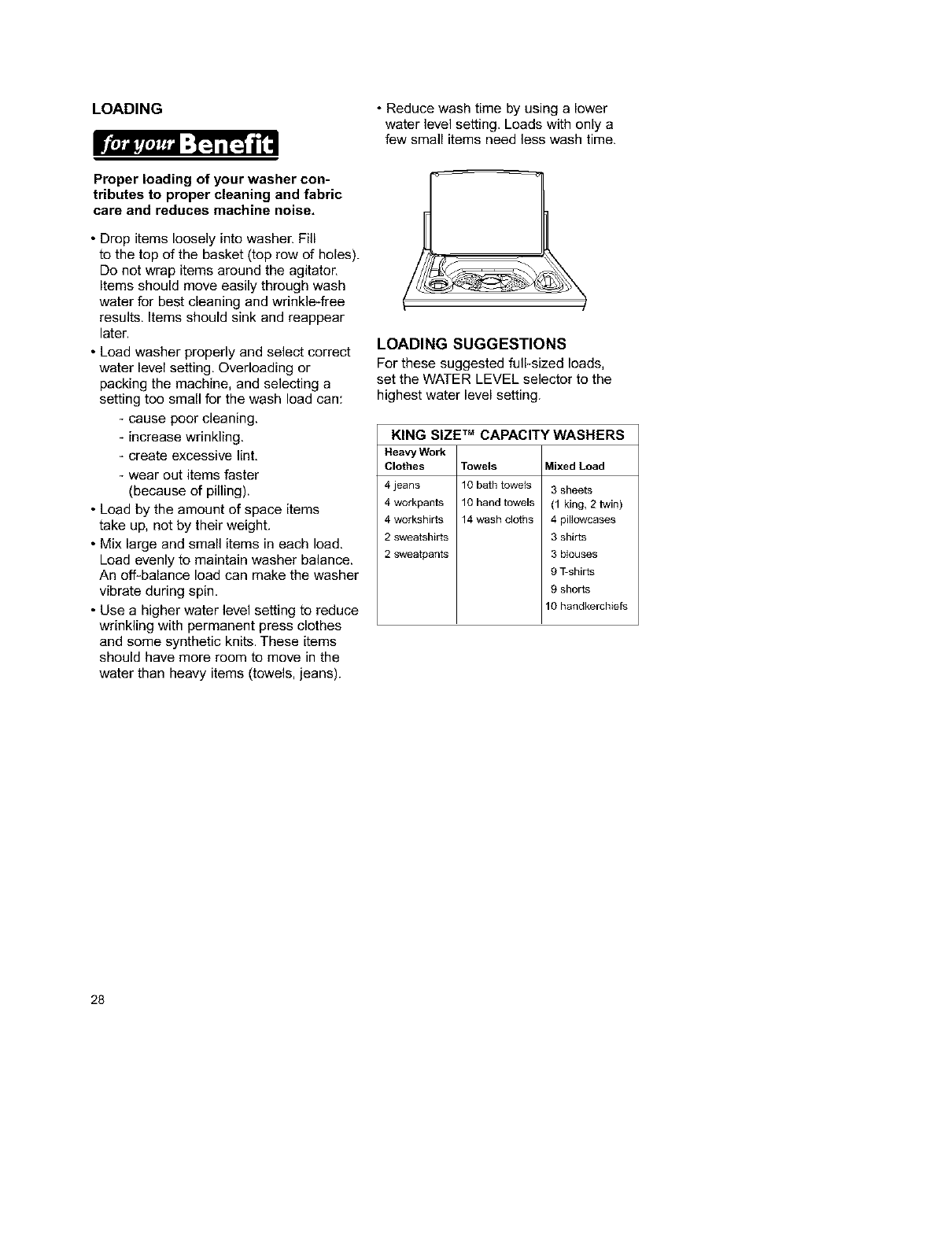
LOADING • Reduce wash time by using a lower
water level setting. Loads with only a
few small items need less wash time.
Proper loading of your washer con-
tributes to proper cleaning and fabric
care and reduces machine noise,
• Drop items loosely into washer. Fill
to the top of the basket (top row of holes).
Do not wrap items around the agitator,
Items should move easily through wash
water for best cleaning and wrinkle-free
results, Items should sink and reappear
later.
• Load washer properly and select correct
water level setting. Overloading or
packing the machine, and selecting a
setting too small for the wash load can:
- cause poor cleaning.
- increase wrinkling.
- create excessive lint.
- wear out items faster
(because of pilling).
• Load by the amount of space items
take up, not by their weight.
• Mix large and small items in each load.
Load evenly to maintain washer balance.
An off-balance load can make the washer
vibrate during spin.
• Use a higher water level setting to reduce
wrinkling with permanent press clothes
and some synthetic knits. These items
should have more room to move in the
water than heavy items (towels, jeans).
LOADING SUGGESTIONS
For these suggested full-sized loads,
set the WATER LEVEL selector to the
highest water level setting.
KING SIZE TM CAPACITY WASHERS
Heavy Work
Clothes
4 jeans
4 workpants
4 workshirts
2 sweatshirts
2 sweatpants
Towels Mixed Load
10 hath towels 3 sheets
10 hand towels (1 king, 2 twin)
14 wash cloths 4 pillowcases
3 shirts
3 blouses
9 T-shirts
9 shorts
10 handkerchiefs
28
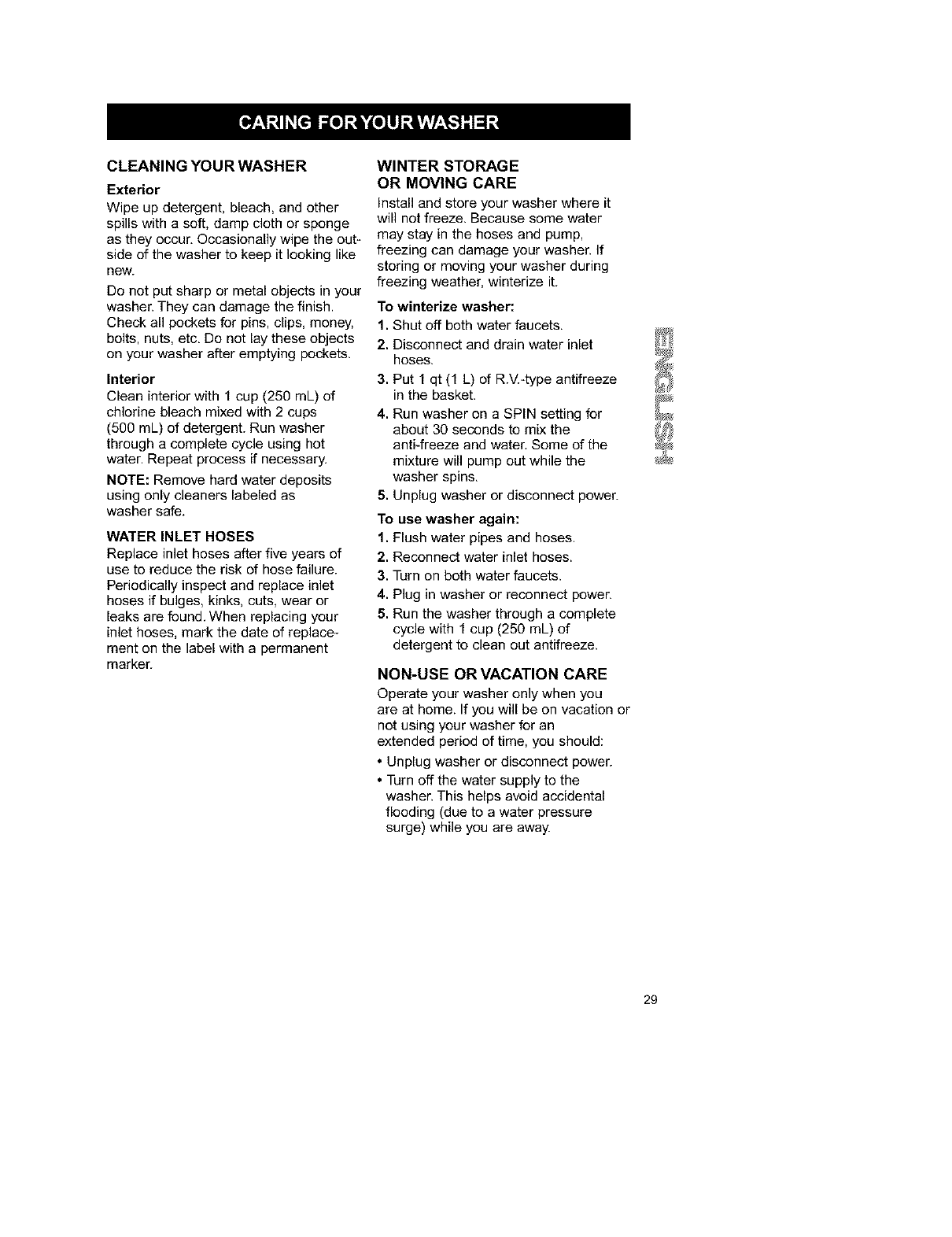
CLEANING YOUR WASHER
Exterior
Wipe up detergent, bleach, and other
spills with a soft, damp cloth or sponge
as they occur, Occasionally wipe the out-
side of the washer to keep it looking like
new.
Do not put sharp or metal objects in your
washer. They can damage the finish.
Check all pockets for pins, clips, money,
bolts, nuts, etc. Do not lay these objects
on your washer after emptying pockets.
Interior
Clean interior with 1 cup (250 mL) of
chlorine bleach mixed with 2 cups
(500 mL) of detergent. Run washer
through a complete cycle using hot
water. Repeat process if necessary.
NOTE: Remove hard water deposits
using only cleaners labeled as
washer safe.
WATER INLET HOSES
Replace inlet hoses after five years of
use to reduce the risk of hose failure.
Periodically inspect and replace inlet
hoses if bulges, kinks, cuts, wear or
leaks are found. When replacing your
inlet hoses, mark the date of replace-
ment on the label with a permanent
marker.
WINTER STORAGE
OR MOVING CARE
Install and store your washer where it
will not freeze. Because some water
may stay in the hoses and pump,
freezing can damage your washer. If
storing or moving your washer during
freezing weather, winterize it.
To winterize washer:
1. Shut off both water faucets,
2. Disconnect and drain water inlet
hoses.
3. Put 1 qt (1 L) of R.V.-type antifreeze
in the basket.
4. Run washer on a SPIN setting for
about 30 seconds to mix the
anti-freeze and water. Some of the
mixture will pump out while the
washer spins.
5. Unplug washer or disconnect power.
To use washer again:
1. Flush water pipes and hoses.
2. Reconnect water inlet hoses.
3. Turn on both water faucets.
4. Plug in washer or reconnect power.
5. Run the washer through a complete
cycle with 1 cup (250 mL) of
detergent to clean out antifreeze.
NON-USE OR VACATION CARE
Operate your washer only when you
are at home. If you will be on vacation or
not using your washer for an
extended period of time, you should:
• Unplug washer or disconnect power.
• Turn off the water supply to the
washer. This helps avoid accidental
flooding (due to a water pressure
surge) while you are away.
29
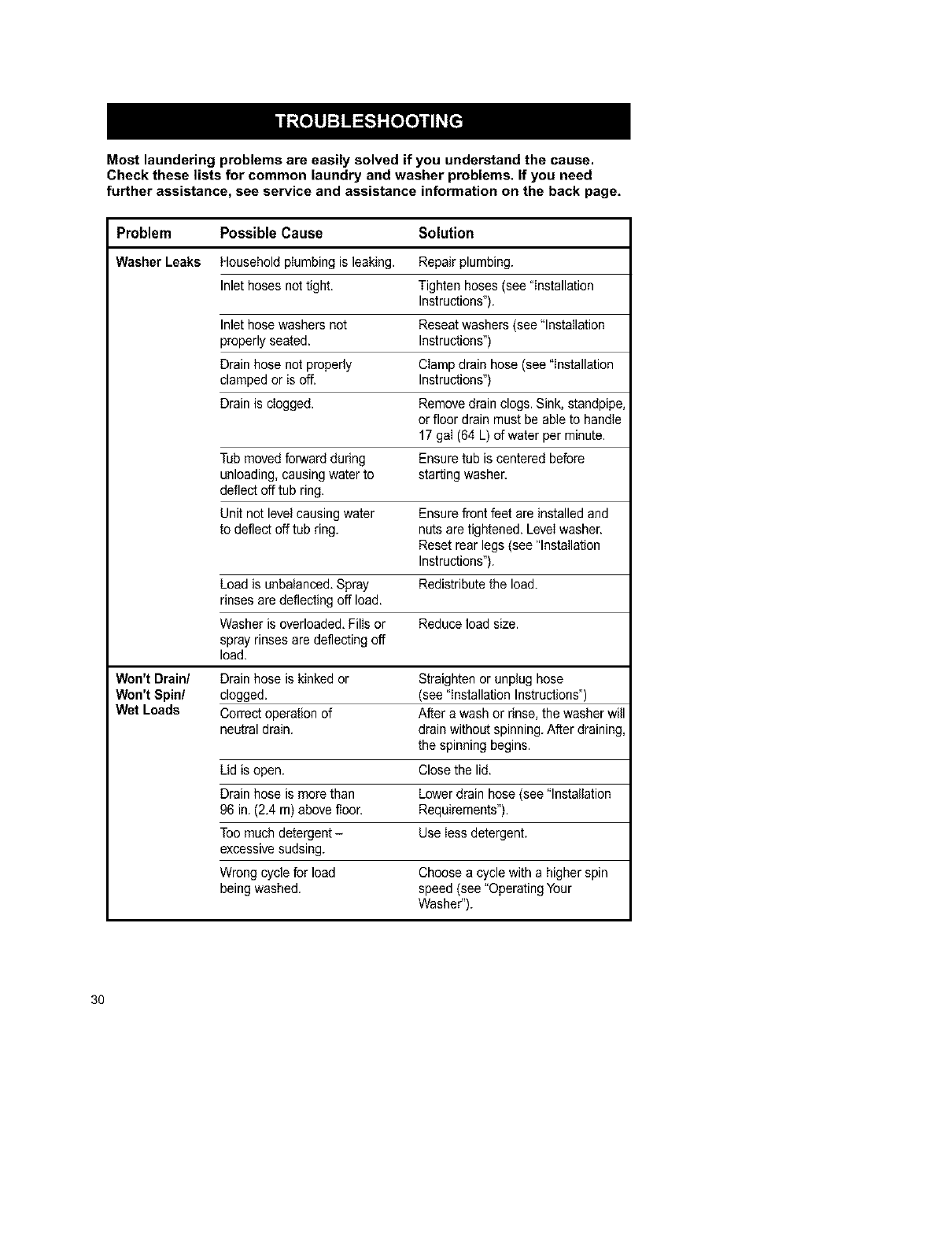
Most laundering problems are easily solved if you understand the cause.
Check these lists for common laundry and washer problems, if you need
further assistance, see service and assistance information on the back page,
Problem Possible Cause Solution
Washer Leaks Household plumbing is leaking. Repair plumbing.
Inlet hoses not tight. Tighten hoses (see "Installation
Instructions").
Inlet hose washers not Reseat washers (see "Installation
properly seated. Instructions")
Drain hose not properly Clamp drain hose (see 'Installation
clamped or is off. Instructions")
Drain is clogged. Removedrain clogs. Sink, standpipe,
or floor drain must be able to handle
17 gaI (64 L) of water per minute.
Tub moved forwardduring Ensure tub is centered before
unloading, causingwater to starting washer.
deflect off tub ring.
Unit not level causing water Ensure front feet are installedand
to deflect off tub ring. nuts are tightened. LeveIwasher.
Reset rear legs (see "Installation
Instructions").
Load isunbalanced. Spray Redistributethe load.
rinses are deflecting off load.
Washer is overloaded. Fills or Reduce load size.
spray rinses are deflecting off
load.
Won't Drain/ Drain hose is kinked or Straighten or unplug hose
Won't Spin/ clogged. (see "Installation Instructions")
Wet Loads Correct operation of After a wash or rinse, the washer will
neutral drain, drain without spinning. After draining,
the spinning begins.
Lid isopen. Close the lid,
Drain hose is more than Lowerdrain hose (see "Installation
96 in. (2.4 m) above floor. Requirements"),
Too much detergent- Use less detergent.
excessivesudsing.
Wrong cycle for load Choose a cycle with a higher spin
being washed, speed (see "Operating Your
Washer").
3O

Problem Possible Cause Solution
Won't Drain/ Low voltage or using Check electrical source or call
Won't Spin/ an extension cord. electrician. Do not use extension
Wet Loads cords.
(cont,)
Cold rinses. Cold rinses leave loads wetter than
warm rinses. This is normal.
Continues Drain hose is less than Raise the drain hose
to Fill/ 39 in (99 cm) above floor. (see "Installation Requirements").
Continues
to Drain/ Drain hose fits tighfly into Adjust drain hose for loose fit
Cycle Stuck standpipe. (see "Installation Instructions").
Drain hose taped into Do not seal off drain hose with tape.
standpipe. The drain hose needs an air gap.
Washer Makes Load is unbalanced. Redistribute load.
Noise
Washer is not level Level washer. Reset rear legs
Rear leveling legs not set. (see "Installation Instructions").
Nuts on front feet not tight. Tighten nuts (see "Installation
Instructions").
Yellow shipping strap with Remove strap with cotter pins
cotter pins not completely (see "Installation Instructions").
removed.
Floor not strong enough Relocate washer (see "Installation
to support washer. Requirements"),
Gears engaging after drain This is normal.
and before spin.
Upper part of agitator clicks This is normal.
during wash,
Won't Water inlet valve Clean screens,
Fill/Won't screens are plugged.
Rinse/Won't
Agitate/ Water is turned off. Turn on water.
Wrong Hot and cold hoses are Reverse hoses (see "Installation
Temperature reversed. Instructions").
Inlet hose is kinked. Straighten hoses.
Timer dial is not lined up. Turn timer knob to the right slightly
and pull to start.
Power cord not plugged in. Plug into a grounded 3 prong outlet.
31
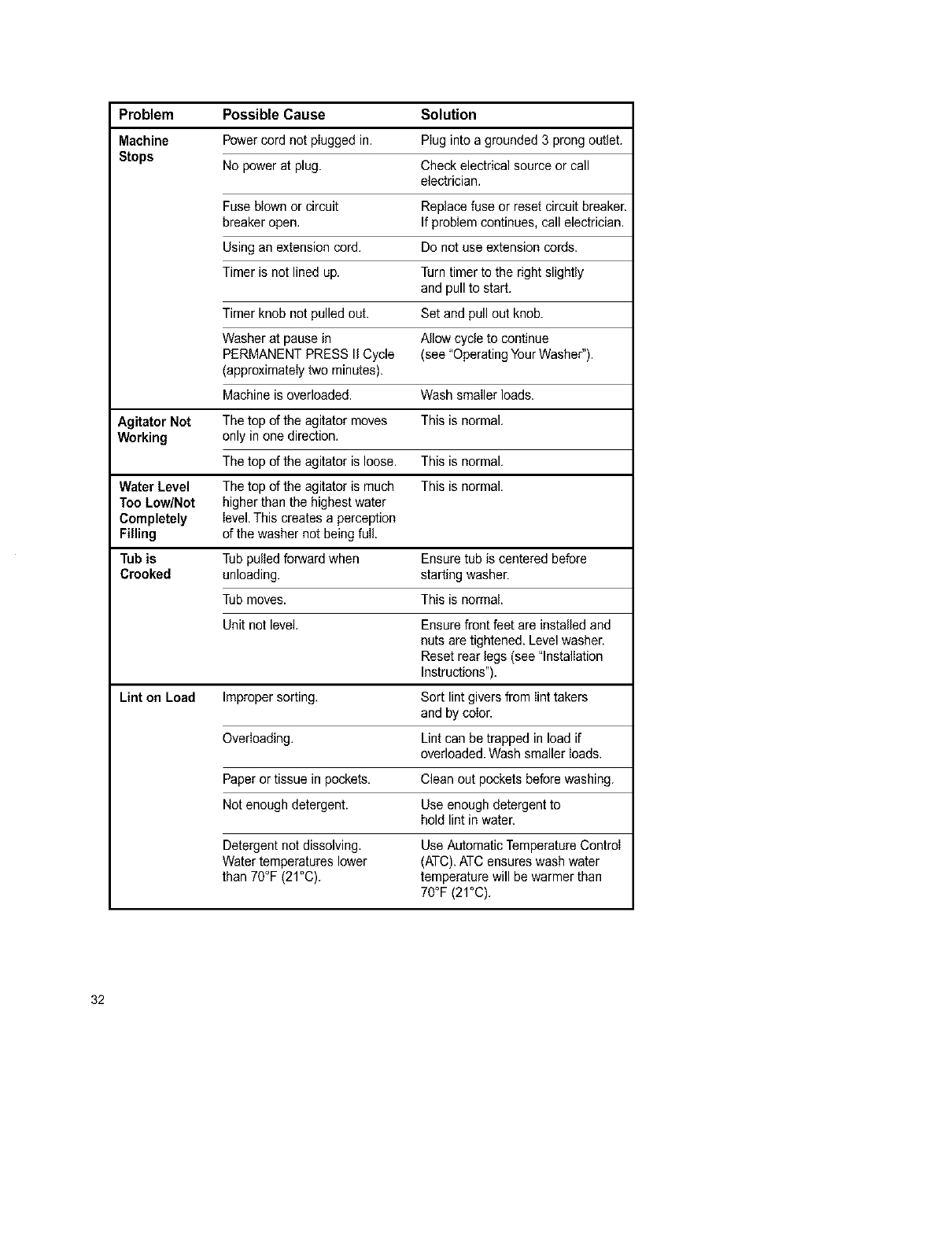
Problem Possible Cause Solution
Machine Power cord not plugged in. Plug into a grounded 3 prong outlet.
Stops No power at plug. Check electrical source or call
electrician.
Fuse blown or circuit Replace fuse or reset circuit breaker.
breaker open. If problem continues, call electrician.
Using an extension cord. Do not use extension cords.
Timer is not lined up. Turn timer to the right slightly
and pull to start.
Timer knob not pulled out. Set and pull out knob.
Washer at pause in Allow cycle to continue
PERMANENT PRESS II Cycle (see "OperatingYourWashe¢').
(approximately two minutes).
Machine is overloaded. Wash smaller loads.
Agitator Not The top of the agitator moves This is normal.
Working only in one direction.
The top of the agitator is loose. This is normal.
Water Level The top of the agitator is much This is normal.
Too Low/Not higher than the highest water
Completely Ievel.This creates a perception
Filling of the washer not being fuIl.
Tub is Tubpulled forward when Ensure tub is centered before
Crooked unloading, starting washer.
Tubmoves. This is normal.
Unit not level. Ensure front feet are installed and
nuts are tightened. Levelwasher.
Reset rear legs (see "lnstalIation
Instructions").
Lint on Load Improper sorting. Sort lint givers from lint takers
and by color.
Overloading. Lint can be trapped in load if
overloaded.Wash smaller loads.
Paper or tissue in pockets. Clean out pockets before washing.
Not enough detergent. Use enough detergent to
hold lint in water.
Detergent not dissolving. Use Automatic Temperature ControI
Water temperatures lower (ATC).ATC ensures wash water
than 70°F (21°C). temperature will be warmer than
70°F (21°C).
32
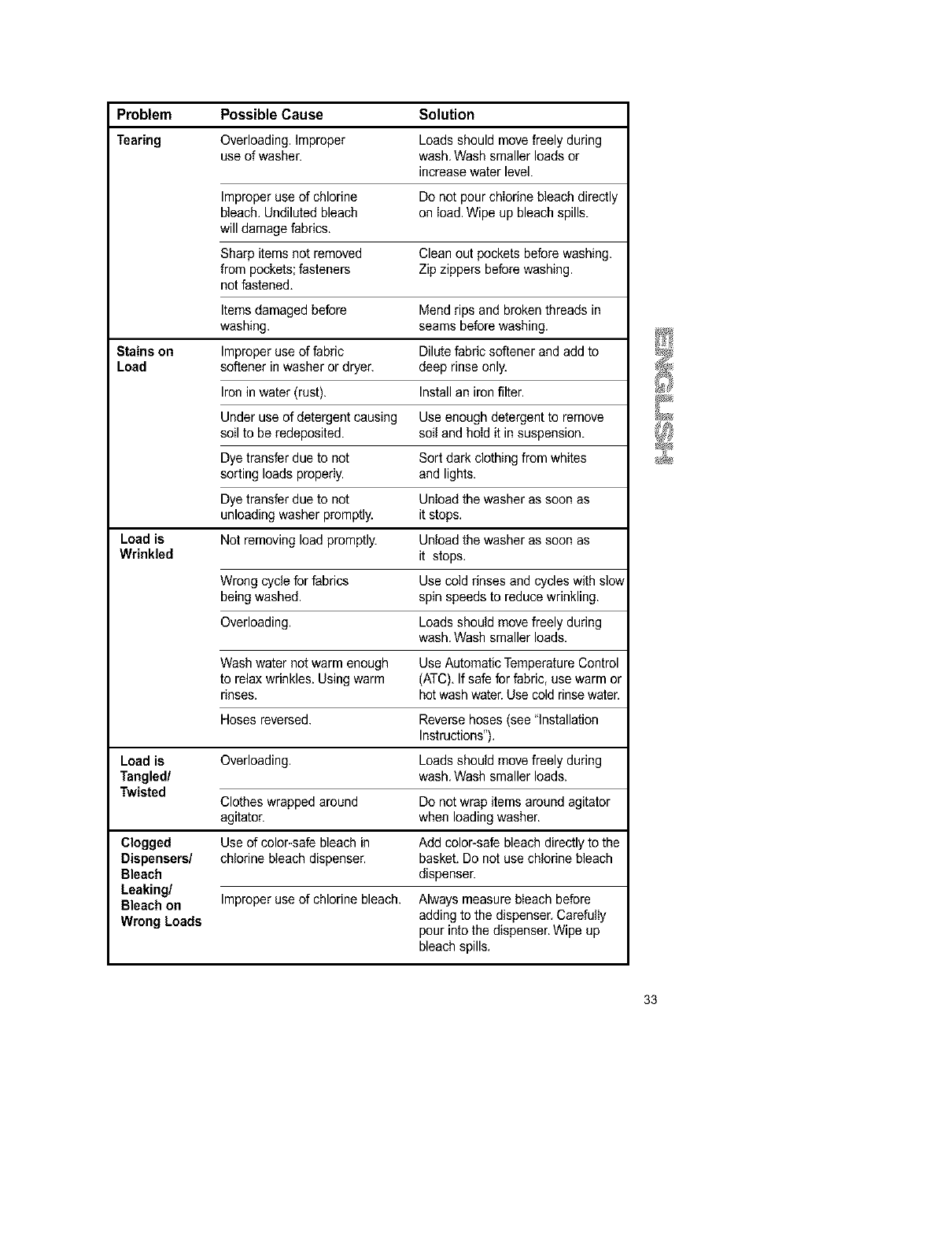
Problem Possible Cause Solution
Tearing Overloading. Improper Loads should move freely during
use of washer, wash.Wash smaller loads or
increase water level.
Improper use of chlorine Do not pour chlorine bleach directly
bleach. Undiluted bleach on load. Wipe up bleach spills.
will damage fabrics.
Sharp items not removed Clean out pockets beforewashing.
from pockets;fasteners Zip zippers before washing.
not fastened.
Items damaged before Mend rips and broken threads in
washing, seams before washing.
Stains on Improper use of fabric Dilute fabric softener and add to
Load softener in washer or dryer, deep rinse only.
Iron in water (rust). Install an iron filter.
Under use of detergent causing Use enough detergent to remove
soil to be redeposited, soil and hold it in suspension.
Dye transfer due to not Sort dark clothing from whites
sorting loads properly, and lights.
Dye transfer due to not Unload the washer as soon as
unloading washer promptly, it stops.
Load is Not removing load promptly. Unload the washer as soon as
Wrinkled it stops.
Wrong cycle for fabrics Use cold rinses and cycles with slow
being washed, spin speeds to reduce wrinkling.
Overloading. Loads should move freely during
wash.Wash smaller loads.
Wash water not warm enough Use Automatic TemperatureControl
to relax wrinkles. Using warm (ATC). If safe for fabric, use warm or
rinses, hot wash water.Use coldrinse water.
Hoses reversed. Reverse hoses (see "Installation
Instructions").
Load is Overloading. Loads should move freely during
Tangled/ wash.Wash smaller loads.
Twisted
Clothes wrapped around Do notwrap items around agitator
agitator, when loadingwasher.
Clogged Use of color-safe bleach in Add color-safe bleach directly to the
Dispensers/ chlorine bleach dispenser, basket. Do not use chlorine bleach
Bleach dispenser.
Leaking/
Bleach on Improper use of chlorine bleach. Always measure bleach before
Wrong Loads adding to the dispenser.Carefully
pour into the dispenser.Wipe up
bleach spills.
33
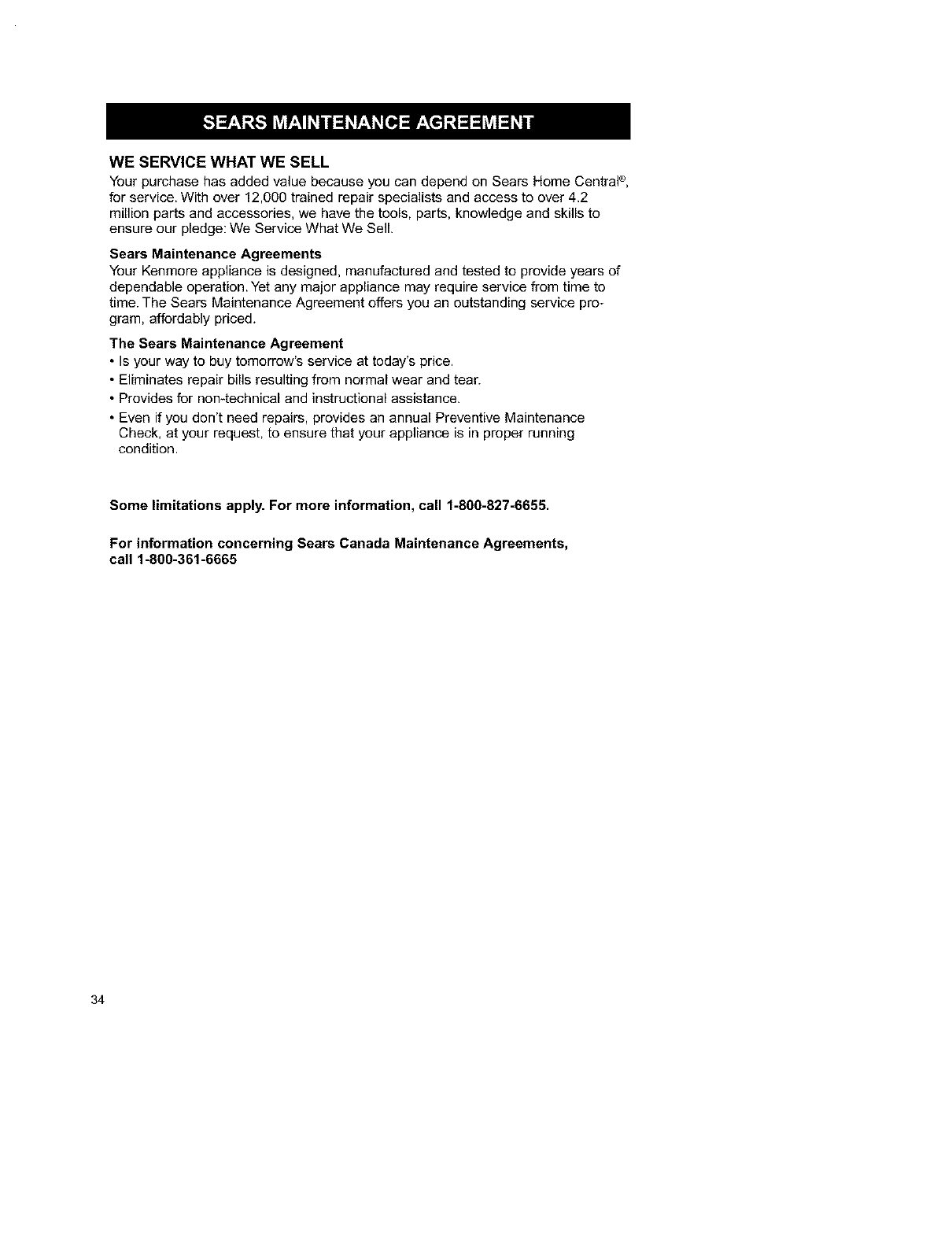
WE SERVICE WHAT WE SELL
Your purchase has added value because you can depend on Sears Home Central °,
for service. With over 12,000 trained repair specialists and access to over 4.2
million parts and accessories, we have the tools, parts, knowledge and skills to
ensure our pledge: We Service What We Sell.
Sears Maintenance Agreements
Your Kenmore appliance is designed, manufactured and tested to provide years of
dependable operation. Yet any major appliance may require service from time to
time. The Sears Maintenance Agreement offers you an outstanding service pro-
gram, affordably priced.
The Sears Maintenance Agreement
• Is your way to buy tomorrow's service at today's price.
• Eliminates repair bills resulting from normal wear and tear.
• Provides for non-technical and instructional assistance.
• Even if you don't need repairs, provides an annual Preventive Maintenance
Check, at your request, to ensure that your appliance is in proper running
condition.
Some limitations apply. For more information, call 1-800-827-6655.
For information concerning Sears Canada Maintenance Agreements,
call 1-800-361-6665
34
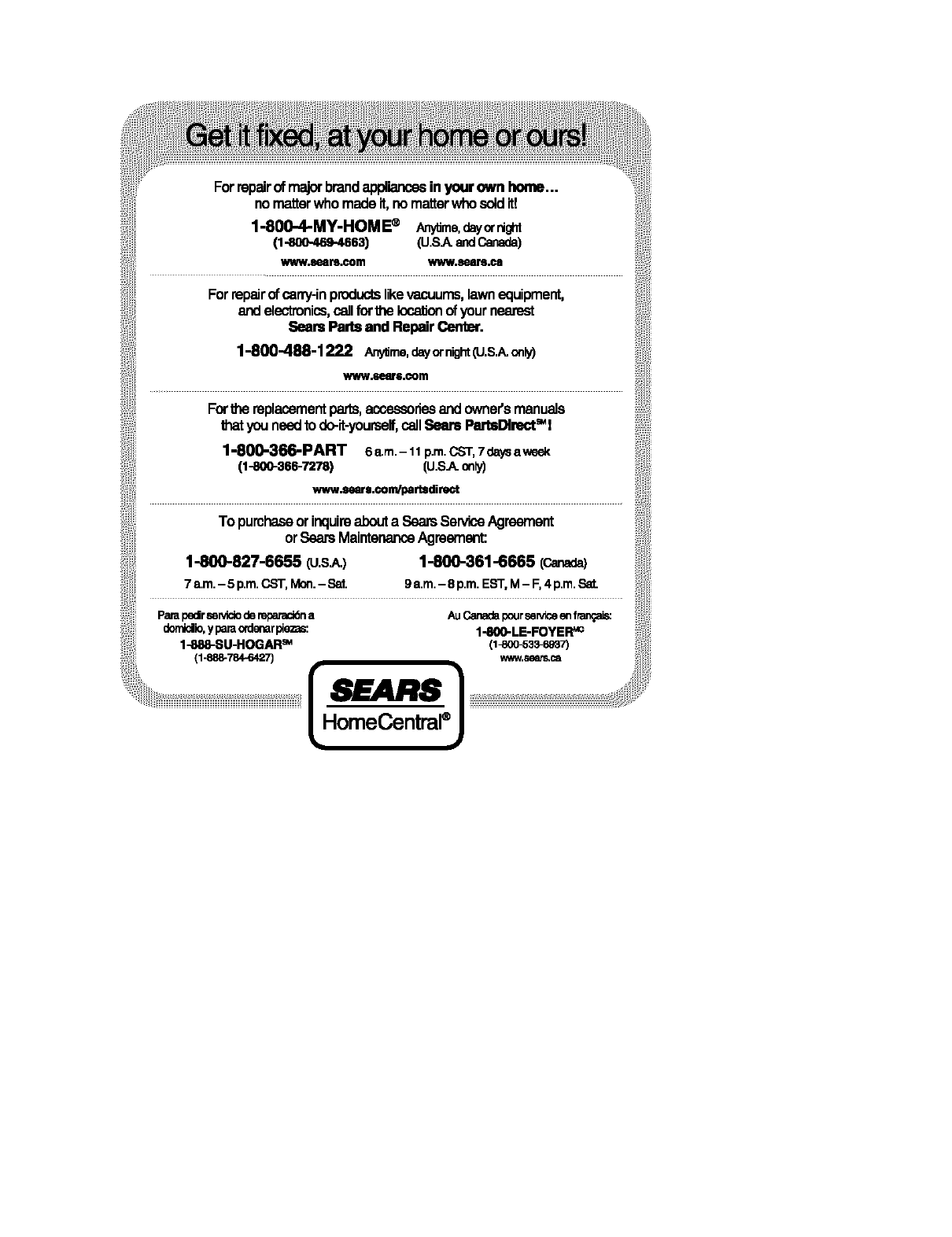
Forrepairof major brand appliancesin your own home...
nomatter who made it,no matterwho sold it!
1-800-4-MY-HOME ® Any_me,dayornight
(1-800-468-4663) (U.SA andCanada)
www.aelrs.com wwY/.sesrs.cll
For repairof carry-inproductslikevacuums, lawnequipment,
and electronics,call for the Ioca_onof your nearest
Sears Parts and Repair Center.
1-800-488-1222 AnyUme,dayornight(U.S.A.only)
www.seers.com
Forthe replacement pads, accassodesand c_lneCsmanuals
_9.t you need to do-it-yourself,call Sears PartsDIrect =1
1-800-366-PART So.re.-11 p.m.CST,7daysaweek
(1-800-366-7278) (U.SA only)
www.sear $.condpartsdirect
To purchaseorinquireabouta SearsServiceAgreement
orSearsMaintenanceAgreement:
1-800-827-6655 (u.sA.) 1-800-361-6665 (Canada)
7a.m. - 5 p.m.CST, Mort.- Sat. 9a.m.- 8 p.m. EST, M- F,4 p.m. S_t.
ParapedrsenAciodereparac_na
dont:lio,yparaordenarpie_s:
1-888-SU-HOGARsM
0-ese-784-64_
[
AuCanadapoursensee_fran_
1-800-LE-FOYER"c
(1-800-533-6837)
